EAL Learners Support and Monitoring in School X: Experience Report
VerifiedAdded on 2023/04/21
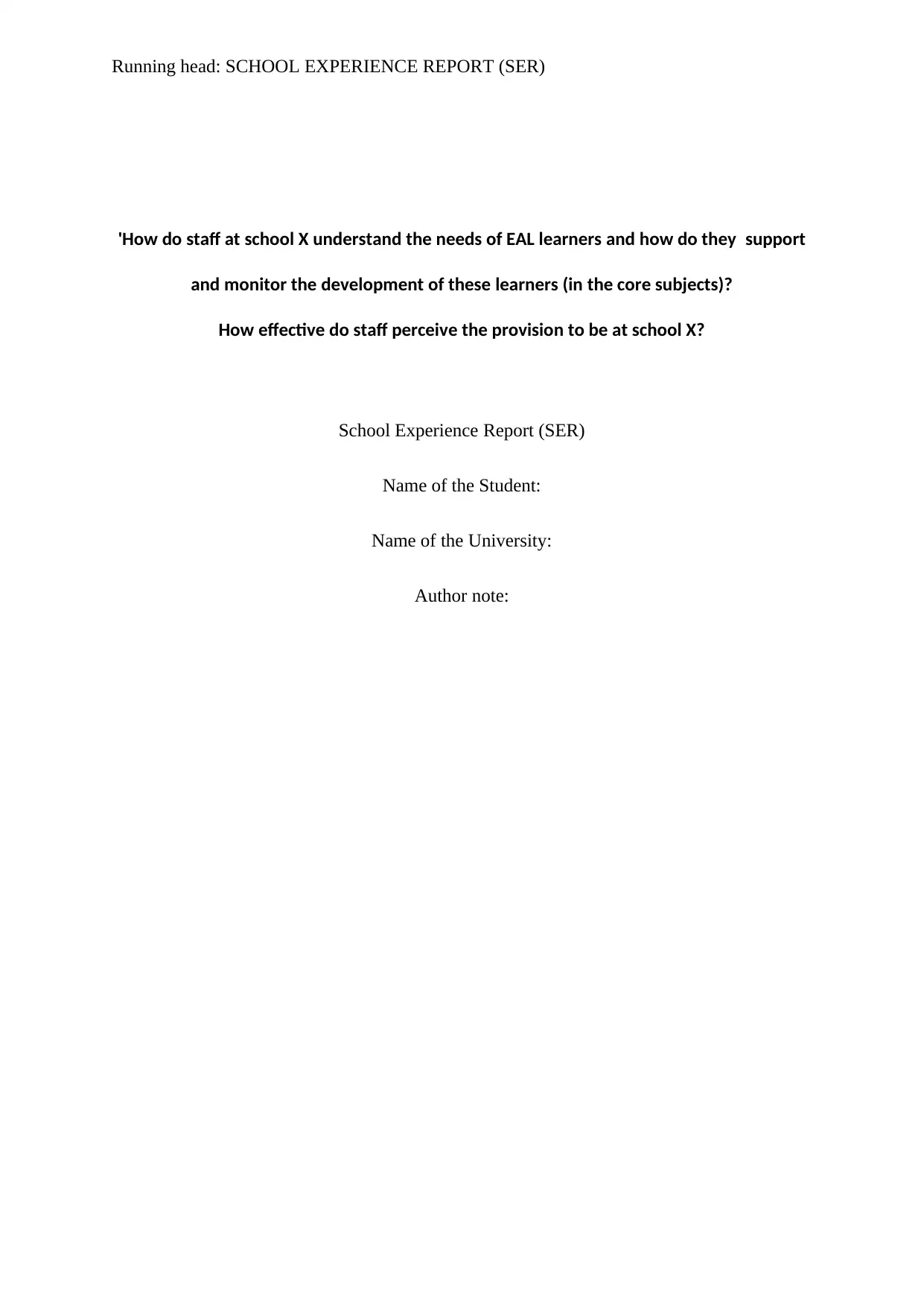
'How do staff at school X understand the needs of EAL learners and how do they support
and monitor the development of these learners (in the core subjects)?
How effective do staff perceive the provision to be at school X?
School Experience Report (SER)
Name of the Student:
Name of the University:
Author note:
Paraphrase This Document

Table of Contents
Introduction................................................................................................................................2
Literature Review.......................................................................................................................4
EAL Interventions..................................................................................................................4
EAL support in Class.............................................................................................................5
EAL........................................................................................................................................7
Summary....................................................................................................................................9
Research Methods....................................................................................................................11
Findings and Discussion..........................................................................................................12
Conclusion................................................................................................................................18
Appendix..................................................................................................................................22
References:...............................................................................................................................33
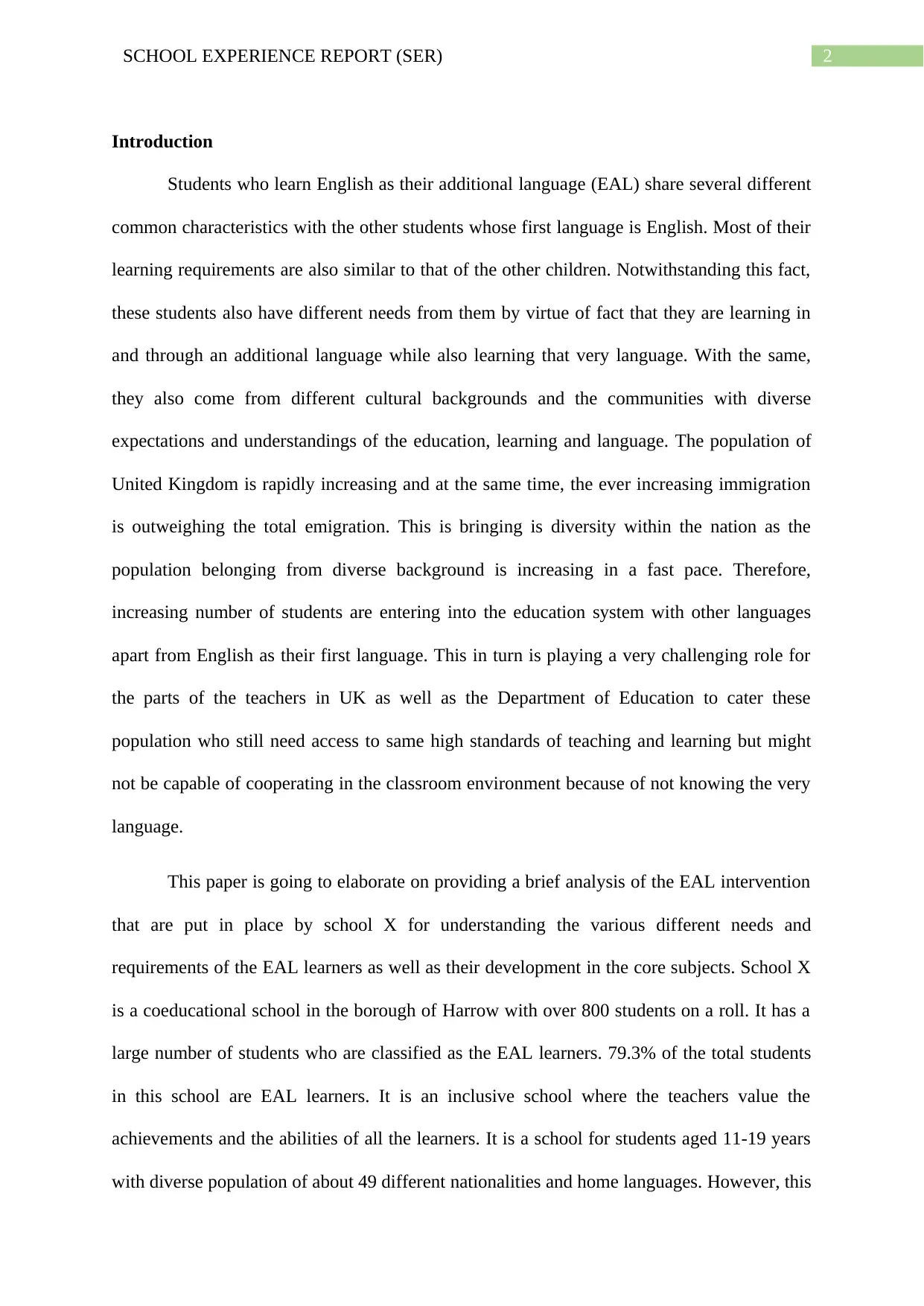
Introduction
Students who learn English as their additional language (EAL) share several different
common characteristics with the other students whose first language is English. Most of their
learning requirements are also similar to that of the other children. Notwithstanding this fact,
these students also have different needs from them by virtue of fact that they are learning in
and through an additional language while also learning that very language. With the same,
they also come from different cultural backgrounds and the communities with diverse
expectations and understandings of the education, learning and language. The population of
United Kingdom is rapidly increasing and at the same time, the ever increasing immigration
is outweighing the total emigration. This is bringing is diversity within the nation as the
population belonging from diverse background is increasing in a fast pace. Therefore,
increasing number of students are entering into the education system with other languages
apart from English as their first language. This in turn is playing a very challenging role for
the parts of the teachers in UK as well as the Department of Education to cater these
population who still need access to same high standards of teaching and learning but might
not be capable of cooperating in the classroom environment because of not knowing the very
language.
This paper is going to elaborate on providing a brief analysis of the EAL intervention
that are put in place by school X for understanding the various different needs and
requirements of the EAL learners as well as their development in the core subjects. School X
is a coeducational school in the borough of Harrow with over 800 students on a roll. It has a
large number of students who are classified as the EAL learners. 79.3% of the total students
in this school are EAL learners. It is an inclusive school where the teachers value the
achievements and the abilities of all the learners. It is a school for students aged 11-19 years
with diverse population of about 49 different nationalities and home languages. However, this
⊘ This is a preview!⊘
Do you want full access?
Subscribe today to unlock all pages.

Trusted by 1+ million students worldwide
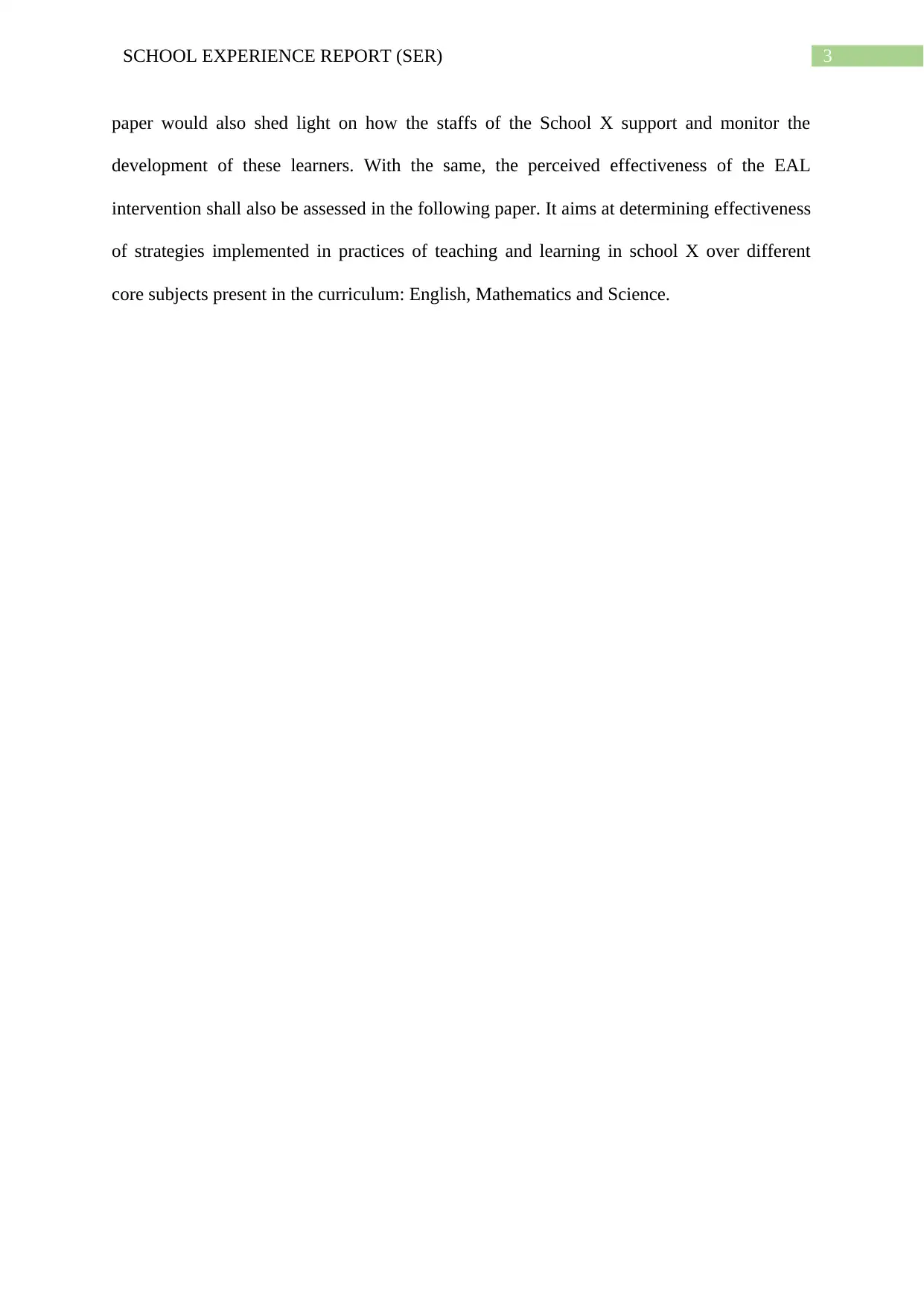
paper would also shed light on how the staffs of the School X support and monitor the
development of these learners. With the same, the perceived effectiveness of the EAL
intervention shall also be assessed in the following paper. It aims at determining effectiveness
of strategies implemented in practices of teaching and learning in school X over different
core subjects present in the curriculum: English, Mathematics and Science.
Paraphrase This Document

Literature Review
EAL Interventions
School X has a clear policy on assessment, within which specific elements relate to
AFL strategies and there are also references to AFL within the school’s teaching and learning
policy. Within the assessment policy there is a strong emphasis on comment only marking
across key stage 3 (p.12), which seems to draw directly from the original AFL research.
Although there is no direct reference to UK government recommendations or policies around
AFL within the school policy document, there are clear echoes of the government’s guidance
document in the section of the school’s policy that indicates how summative assessment may
be used for formative purposes. Policies laid by government states that the students who are
exposed to a particular language at their homes which is known or perceived to be other than
English are referred to as EALs. It is to note that according to the recent study conducted by
Cummins (1992), the national proportion of the students of secondary school who are
classified as the EAL has continuously risen in the past ten years and at present, it stands at
16.2%. This rise has been very stead and is six years behind the percentage points of the EAL
students belonging from the primary schools that at present stands at 20.6% (Siegel and
Lipka 2017). This indicates that most of the students in primary school moved to the
secondary school in United Kingdom and this further demonstrate that they have about six
years of education while having English as their classroom language prior to their entry in the
secondary education level. Notwithstanding this fact, this conclusion cannot be immediately
drawn from these provided statistics in any way. It is also to note that the number of EAL
students are growing with a rapid pace. With the same, it is also imperative that the
provisions are placed for ensuring that they can get an access to all the parts of the curriculum
when it is presented in additional language (Leung 2018). When the students would not be
too different from their peers or class mates, their learning experiences get contrasted.
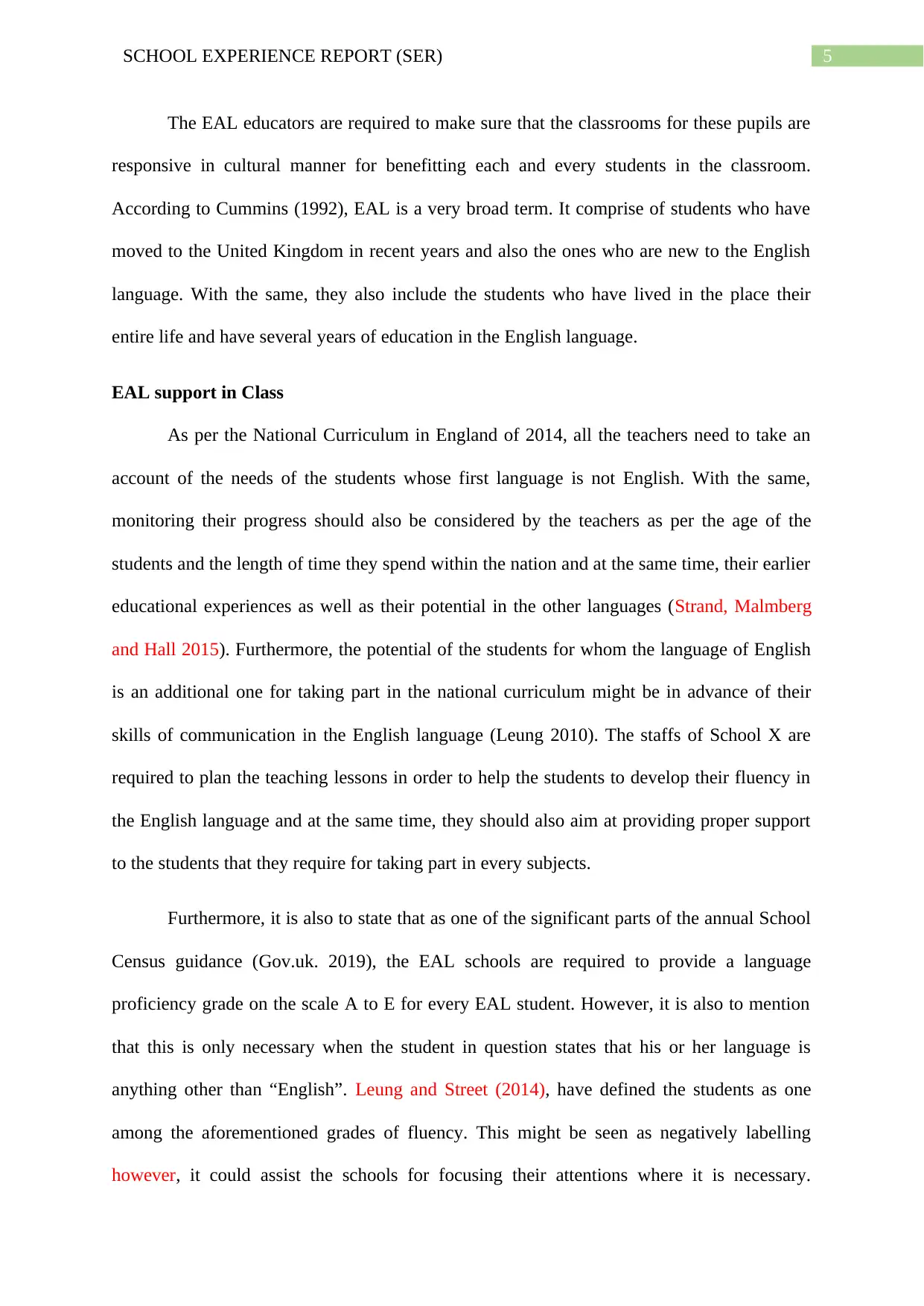
The EAL educators are required to make sure that the classrooms for these pupils are
responsive in cultural manner for benefitting each and every students in the classroom.
According to Cummins (1992), EAL is a very broad term. It comprise of students who have
moved to the United Kingdom in recent years and also the ones who are new to the English
language. With the same, they also include the students who have lived in the place their
entire life and have several years of education in the English language.
EAL support in Class
As per the National Curriculum in England of 2014, all the teachers need to take an
account of the needs of the students whose first language is not English. With the same,
monitoring their progress should also be considered by the teachers as per the age of the
students and the length of time they spend within the nation and at the same time, their earlier
educational experiences as well as their potential in the other languages (Strand, Malmberg
and Hall 2015). Furthermore, the potential of the students for whom the language of English
is an additional one for taking part in the national curriculum might be in advance of their
skills of communication in the English language (Leung 2010). The staffs of School X are
required to plan the teaching lessons in order to help the students to develop their fluency in
the English language and at the same time, they should also aim at providing proper support
to the students that they require for taking part in every subjects.
Furthermore, it is also to state that as one of the significant parts of the annual School
Census guidance (Gov.uk. 2019), the EAL schools are required to provide a language
proficiency grade on the scale A to E for every EAL student. However, it is also to mention
that this is only necessary when the student in question states that his or her language is
anything other than “English”. Leung and Street (2014), have defined the students as one
among the aforementioned grades of fluency. This might be seen as negatively labelling
however, it could assist the schools for focusing their attentions where it is necessary.
⊘ This is a preview!⊘
Do you want full access?
Subscribe today to unlock all pages.

Trusted by 1+ million students worldwide
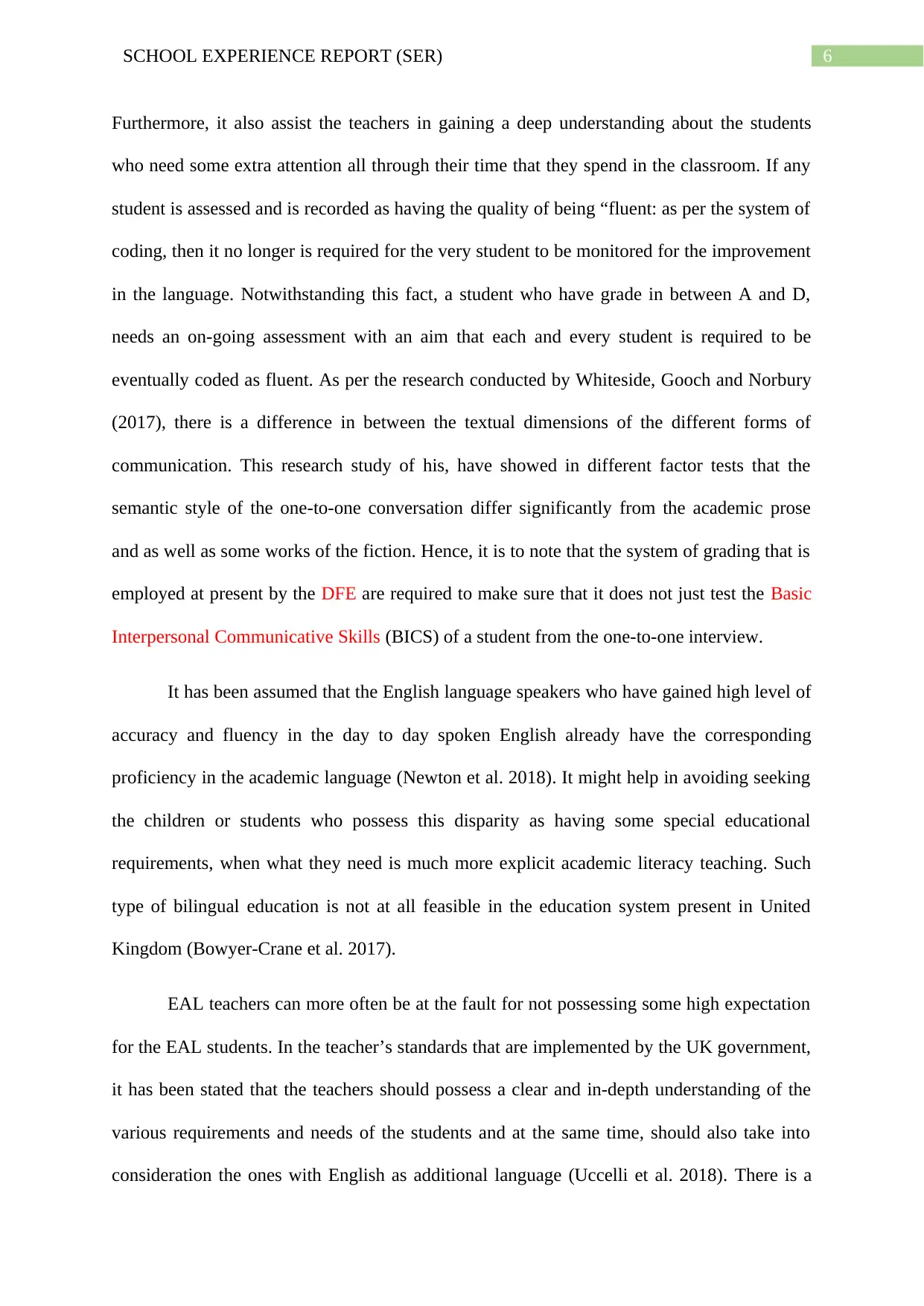
Furthermore, it also assist the teachers in gaining a deep understanding about the students
who need some extra attention all through their time that they spend in the classroom. If any
student is assessed and is recorded as having the quality of being “fluent: as per the system of
coding, then it no longer is required for the very student to be monitored for the improvement
in the language. Notwithstanding this fact, a student who have grade in between A and D,
needs an on-going assessment with an aim that each and every student is required to be
eventually coded as fluent. As per the research conducted by Whiteside, Gooch and Norbury
(2017), there is a difference in between the textual dimensions of the different forms of
communication. This research study of his, have showed in different factor tests that the
semantic style of the one-to-one conversation differ significantly from the academic prose
and as well as some works of the fiction. Hence, it is to note that the system of grading that is
employed at present by the DFE are required to make sure that it does not just test the Basic
Interpersonal Communicative Skills (BICS) of a student from the one-to-one interview.
It has been assumed that the English language speakers who have gained high level of
accuracy and fluency in the day to day spoken English already have the corresponding
proficiency in the academic language (Newton et al. 2018). It might help in avoiding seeking
the children or students who possess this disparity as having some special educational
requirements, when what they need is much more explicit academic literacy teaching. Such
type of bilingual education is not at all feasible in the education system present in United
Kingdom (Bowyer-Crane et al. 2017).
EAL teachers can more often be at the fault for not possessing some high expectation
for the EAL students. In the teacher’s standards that are implemented by the UK government,
it has been stated that the teachers should possess a clear and in-depth understanding of the
various requirements and needs of the students and at the same time, should also take into
consideration the ones with English as additional language (Uccelli et al. 2018). There is a
Paraphrase This Document
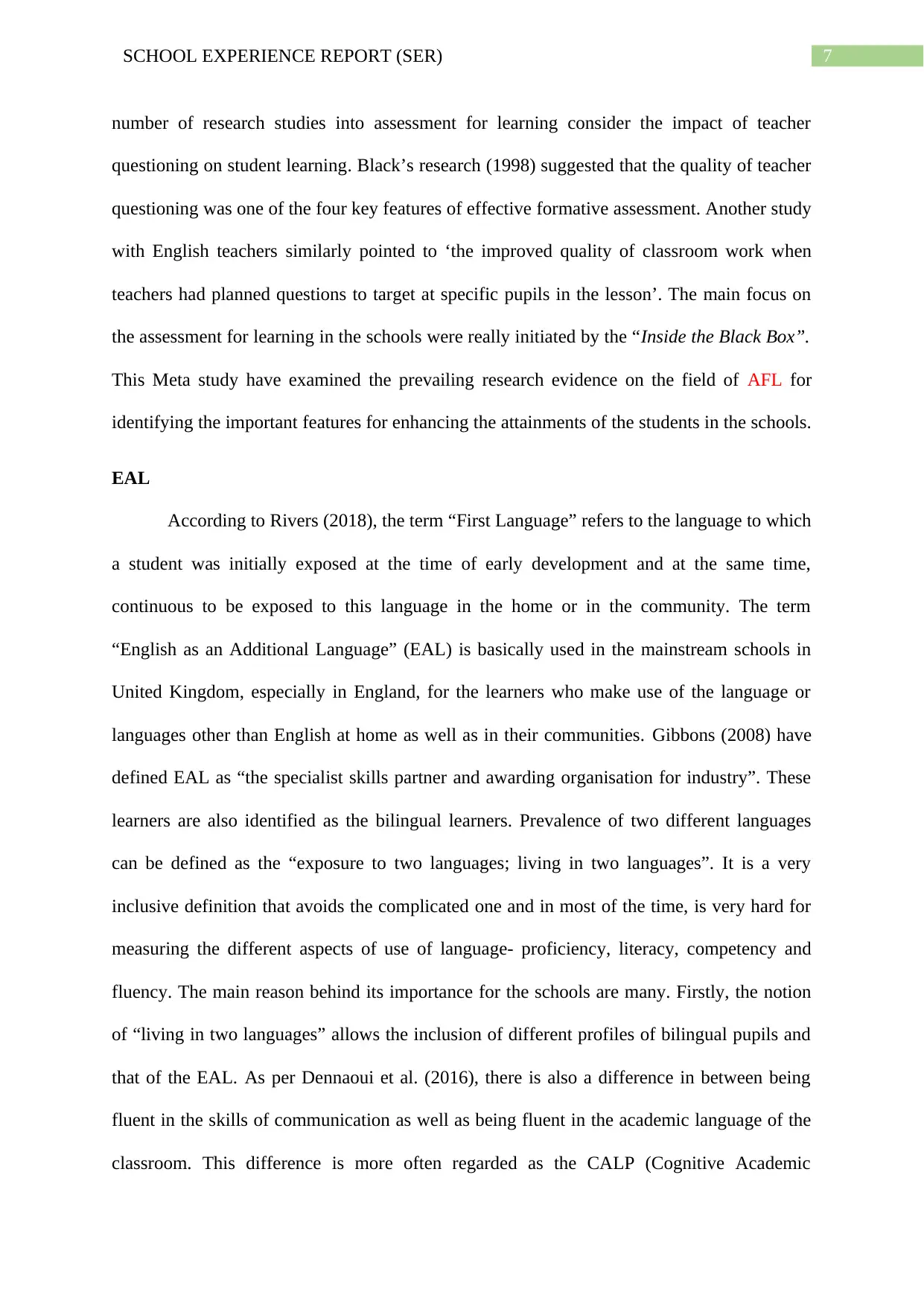
number of research studies into assessment for learning consider the impact of teacher
questioning on student learning. Black’s research (1998) suggested that the quality of teacher
questioning was one of the four key features of effective formative assessment. Another study
with English teachers similarly pointed to ‘the improved quality of classroom work when
teachers had planned questions to target at specific pupils in the lesson’. The main focus on
the assessment for learning in the schools were really initiated by the “Inside the Black Box”.
This Meta study have examined the prevailing research evidence on the field of AFL for
identifying the important features for enhancing the attainments of the students in the schools.
EAL
According to Rivers (2018), the term “First Language” refers to the language to which
a student was initially exposed at the time of early development and at the same time,
continuous to be exposed to this language in the home or in the community. The term
“English as an Additional Language” (EAL) is basically used in the mainstream schools in
United Kingdom, especially in England, for the learners who make use of the language or
languages other than English at home as well as in their communities. Gibbons (2008) have
defined EAL as “the specialist skills partner and awarding organisation for industry”. These
learners are also identified as the bilingual learners. Prevalence of two different languages
can be defined as the “exposure to two languages; living in two languages”. It is a very
inclusive definition that avoids the complicated one and in most of the time, is very hard for
measuring the different aspects of use of language- proficiency, literacy, competency and
fluency. The main reason behind its importance for the schools are many. Firstly, the notion
of “living in two languages” allows the inclusion of different profiles of bilingual pupils and
that of the EAL. As per Dennaoui et al. (2016), there is also a difference in between being
fluent in the skills of communication as well as being fluent in the academic language of the
classroom. This difference is more often regarded as the CALP (Cognitive Academic
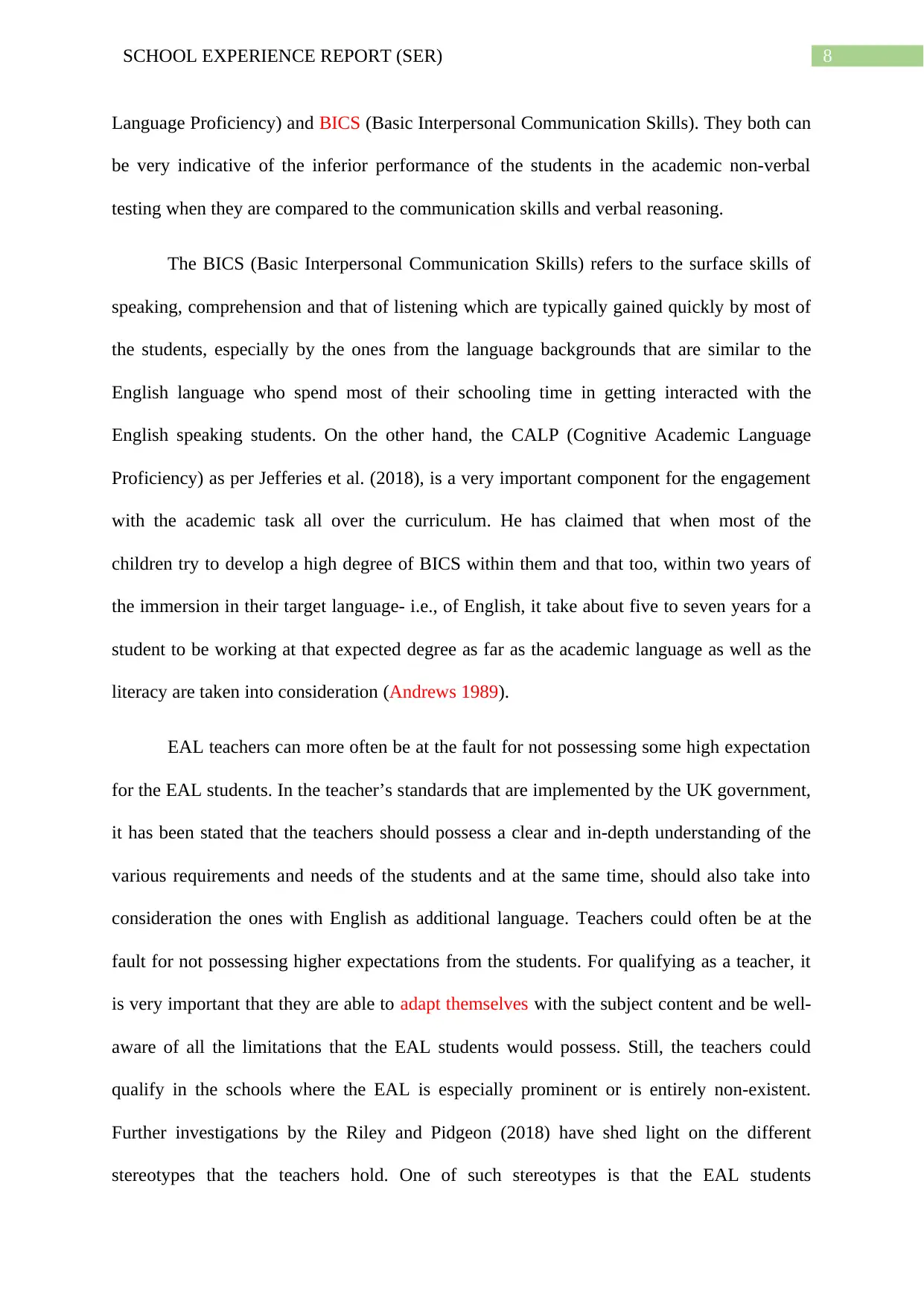
Language Proficiency) and BICS (Basic Interpersonal Communication Skills). They both can
be very indicative of the inferior performance of the students in the academic non-verbal
testing when they are compared to the communication skills and verbal reasoning.
The BICS (Basic Interpersonal Communication Skills) refers to the surface skills of
speaking, comprehension and that of listening which are typically gained quickly by most of
the students, especially by the ones from the language backgrounds that are similar to the
English language who spend most of their schooling time in getting interacted with the
English speaking students. On the other hand, the CALP (Cognitive Academic Language
Proficiency) as per Jefferies et al. (2018), is a very important component for the engagement
with the academic task all over the curriculum. He has claimed that when most of the
children try to develop a high degree of BICS within them and that too, within two years of
the immersion in their target language- i.e., of English, it take about five to seven years for a
student to be working at that expected degree as far as the academic language as well as the
literacy are taken into consideration (Andrews 1989).
EAL teachers can more often be at the fault for not possessing some high expectation
for the EAL students. In the teacher’s standards that are implemented by the UK government,
it has been stated that the teachers should possess a clear and in-depth understanding of the
various requirements and needs of the students and at the same time, should also take into
consideration the ones with English as additional language. Teachers could often be at the
fault for not possessing higher expectations from the students. For qualifying as a teacher, it
is very important that they are able to adapt themselves with the subject content and be well-
aware of all the limitations that the EAL students would possess. Still, the teachers could
qualify in the schools where the EAL is especially prominent or is entirely non-existent.
Further investigations by the Riley and Pidgeon (2018) have shed light on the different
stereotypes that the teachers hold. One of such stereotypes is that the EAL students
⊘ This is a preview!⊘
Do you want full access?
Subscribe today to unlock all pages.

Trusted by 1+ million students worldwide
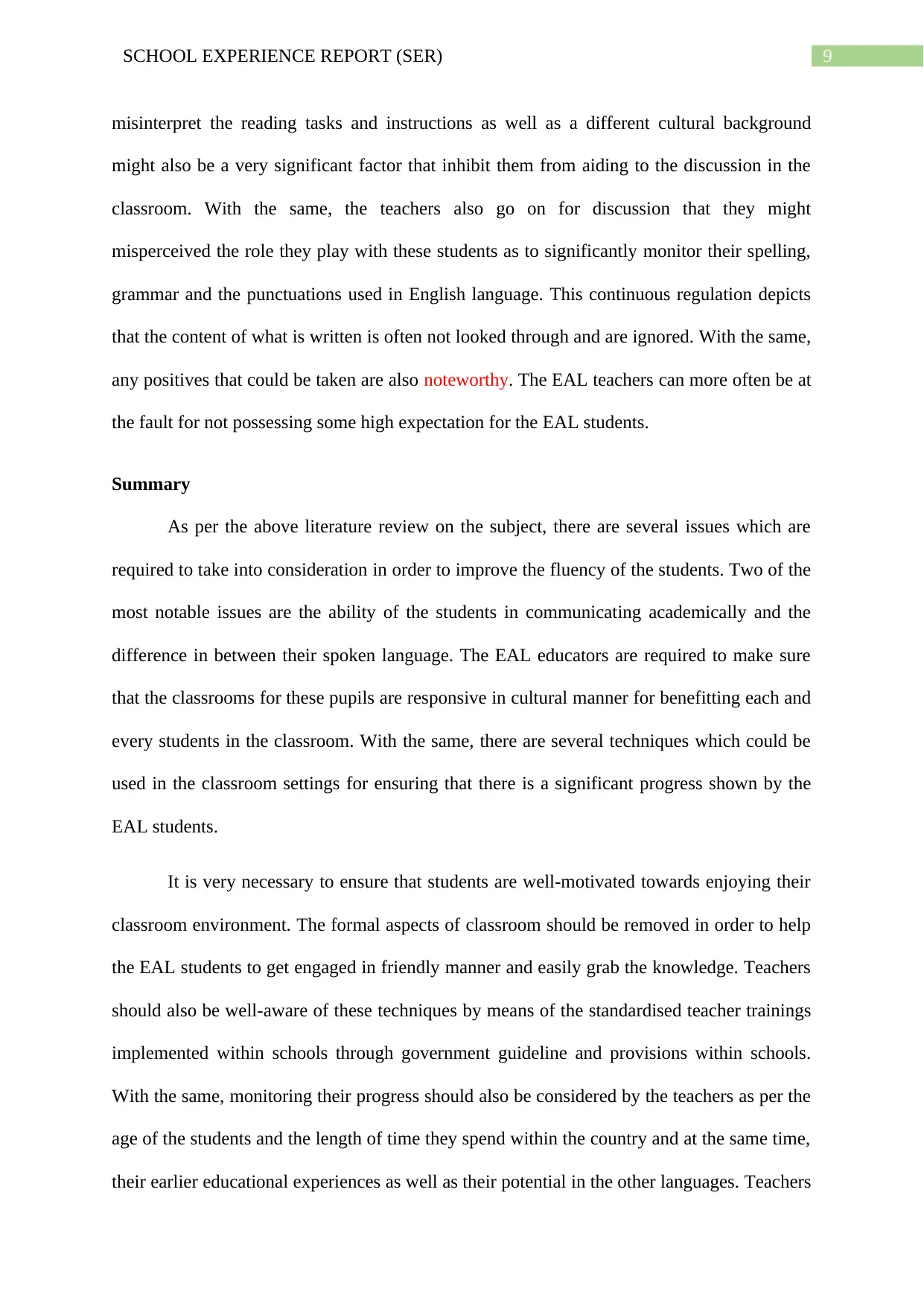
misinterpret the reading tasks and instructions as well as a different cultural background
might also be a very significant factor that inhibit them from aiding to the discussion in the
classroom. With the same, the teachers also go on for discussion that they might
misperceived the role they play with these students as to significantly monitor their spelling,
grammar and the punctuations used in English language. This continuous regulation depicts
that the content of what is written is often not looked through and are ignored. With the same,
any positives that could be taken are also noteworthy. The EAL teachers can more often be at
the fault for not possessing some high expectation for the EAL students.
Summary
As per the above literature review on the subject, there are several issues which are
required to take into consideration in order to improve the fluency of the students. Two of the
most notable issues are the ability of the students in communicating academically and the
difference in between their spoken language. The EAL educators are required to make sure
that the classrooms for these pupils are responsive in cultural manner for benefitting each and
every students in the classroom. With the same, there are several techniques which could be
used in the classroom settings for ensuring that there is a significant progress shown by the
EAL students.
It is very necessary to ensure that students are well-motivated towards enjoying their
classroom environment. The formal aspects of classroom should be removed in order to help
the EAL students to get engaged in friendly manner and easily grab the knowledge. Teachers
should also be well-aware of these techniques by means of the standardised teacher trainings
implemented within schools through government guideline and provisions within schools.
With the same, monitoring their progress should also be considered by the teachers as per the
age of the students and the length of time they spend within the country and at the same time,
their earlier educational experiences as well as their potential in the other languages. Teachers
Paraphrase This Document
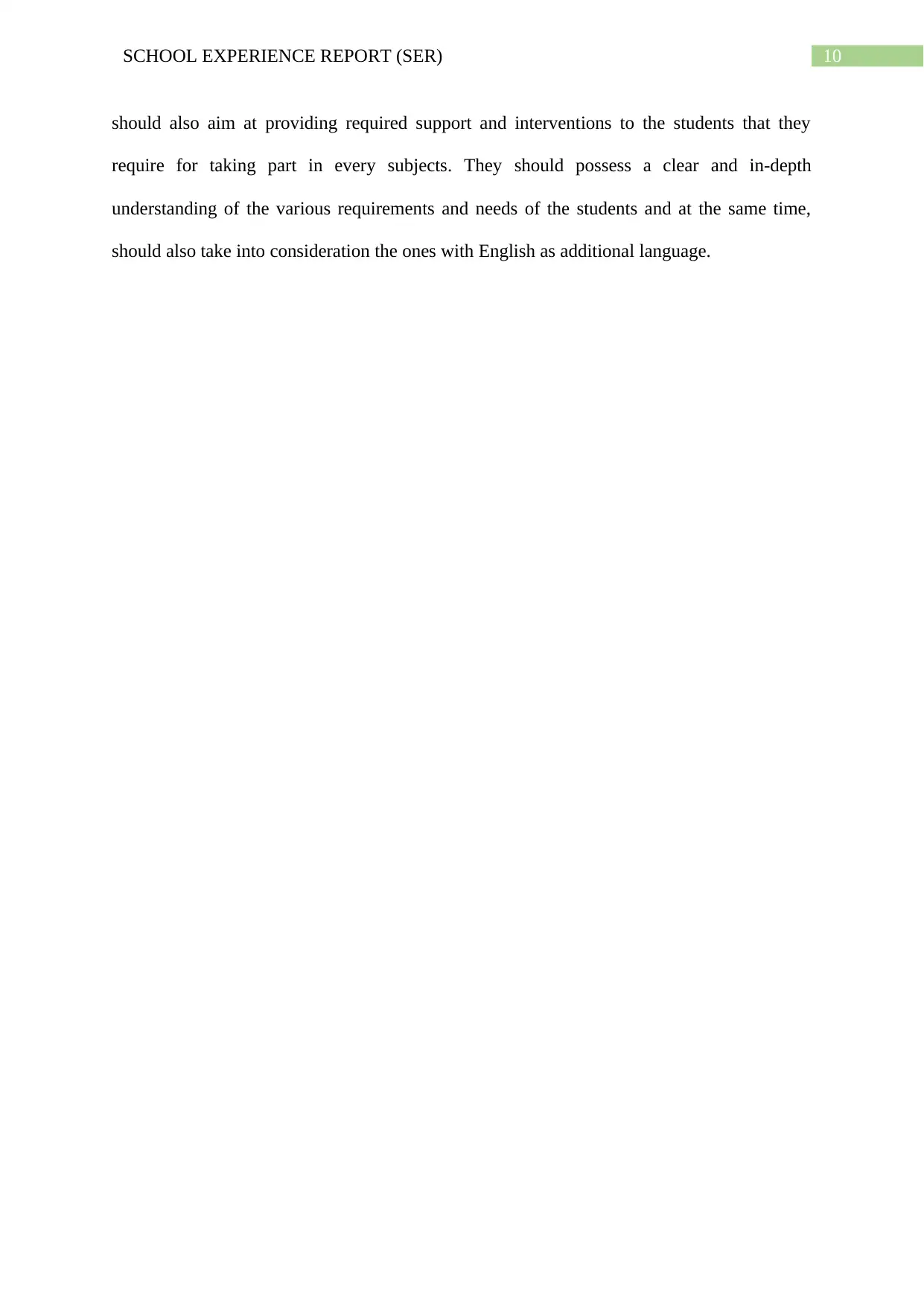
should also aim at providing required support and interventions to the students that they
require for taking part in every subjects. They should possess a clear and in-depth
understanding of the various requirements and needs of the students and at the same time,
should also take into consideration the ones with English as additional language.
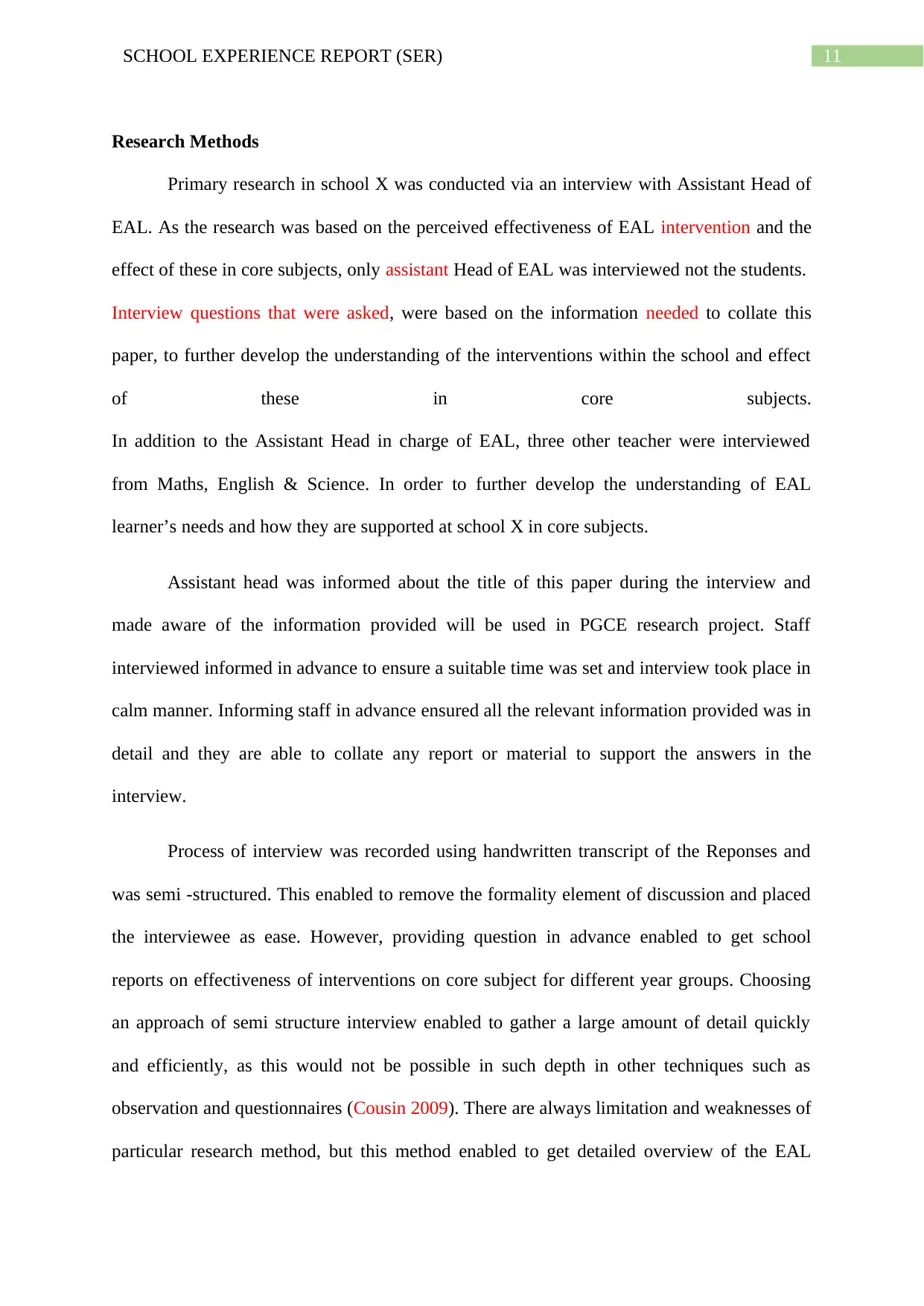
Research Methods
Primary research in school X was conducted via an interview with Assistant Head of
EAL. As the research was based on the perceived effectiveness of EAL intervention and the
effect of these in core subjects, only assistant Head of EAL was interviewed not the students.
Interview questions that were asked, were based on the information needed to collate this
paper, to further develop the understanding of the interventions within the school and effect
of these in core subjects.
In addition to the Assistant Head in charge of EAL, three other teacher were interviewed
from Maths, English & Science. In order to further develop the understanding of EAL
learner’s needs and how they are supported at school X in core subjects.
Assistant head was informed about the title of this paper during the interview and
made aware of the information provided will be used in PGCE research project. Staff
interviewed informed in advance to ensure a suitable time was set and interview took place in
calm manner. Informing staff in advance ensured all the relevant information provided was in
detail and they are able to collate any report or material to support the answers in the
interview.
Process of interview was recorded using handwritten transcript of the Reponses and
was semi -structured. This enabled to remove the formality element of discussion and placed
the interviewee as ease. However, providing question in advance enabled to get school
reports on effectiveness of interventions on core subject for different year groups. Choosing
an approach of semi structure interview enabled to gather a large amount of detail quickly
and efficiently, as this would not be possible in such depth in other techniques such as
observation and questionnaires (Cousin 2009). There are always limitation and weaknesses of
particular research method, but this method enabled to get detailed overview of the EAL
⊘ This is a preview!⊘
Do you want full access?
Subscribe today to unlock all pages.

Trusted by 1+ million students worldwide

interventions and effectiveness of these provision in core subjects. Notwithstanding the fact,
this types of interviews can lead to certain conclusion by having questions leading to a
particular answer, making it bias by the interviewee and the interviewer (O’Leary 2014).
Ethics
Interview participants were made aware of the interview and details of the research
paper in advance. In addition, they were informed that their response would remain
anonymous. The interview was selective in terms of EAL person in charge and three teachers
from core subjects. However, the interviewee was given the opportunity to opt out before
commencing.
Throughout this paper, school name has been kept anonymous as School X, and its
staff with the usage of pseudonyms to each one of them. No audio, video and photos were
taken during the research. All the opinions and critical evaluations of the EAL provision are
of the author and cannot be said to reflecting any of the staff members within the school.
Furthermore, following the research guidelines and school policies all pupil data was
anonymized when used and deleted on submission of this paper.
Findings and Discussion
From the literature review, it is pretty evident that the EAL students are majorly
facing the difficulties in communicating in academic language and along with that, the
difference in their spoken language is also considered to be crucial for the case. As the EAL
learners are seen to belong such families which usually do not communicate in English as the
native language of them are different from it. As a result, the fluency of English is seen to be
absent in the communication of the students and that is a prime reason responsible for the
absence of the required skills for communicating in the academic language. In addition to
this, the absence of the fluency is also instrumental in creating the gap between the desired
Paraphrase This Document

and the actual spoken communication. The idea shared in the literature is significant stating
the fact that the increment in the effectiveness of the training sessions delivered by the EAL
trainers with the incorporation of an environment which is informal and appropriate for the
free flowing communication is the possible and the best suited solution for the mitigation of
the above mentioned gaps in performances of the spoken communication.
School overview
School X has approximately 79% of EAL students and high percentage of mid-term
EAL entrants (Appendix1). 49 languages are spoken at School X, amongst these Romanian is
the most popular at 31%, Arabic 11% and third being Somali 6 % (Appendix2). The finding
is significant in showing a considerably diverse and needy school to provide EAL
intervention to improve literacy and numeracy standards in order to develop the language
skills of the students and do their best in core and other subjects. The finding also make it
pretty visible that it is notably in accordance to the literature of the EAL learners. The
conceptual definition shared in the literature states that the EAL learners are the students who
communicate in other languages in their houses and surroundings compared to English and
from the choice of the school with a precise focus on the characteristics that 49 different
languages which are spoken in it, the achievement of the higher percentage of the EAL
students is justified for the school.
EAL students are identified and assessed using language in Common document and
assessing pupil progress model. All pupils are assessed using EAL assessment during the
entrances process at School X. This enables the school management to categorise them
according to App Levels (Assessing Pupil Progress).
School X has categorised APP in three categories, APP Level 1-2 ,APP Level 2-3 and
APP Level 4 (Appendix 3). There are set number of provisions in place for each set of App

level students, in order for them to develop their literacy skills and leading to the
development to APP level 4 where students are able to return to mainstream classroom and
confidently respond to text and use variety of English language techniques.
Interview with person in charge of EAL
During an interview (Appendix 6) with AA it was informed that due to high
percentage of EAL learners, School X has put in place variety of interventions for students to
progress and develop the skills required to be in mainstream lessons. Once students are
classified according to APP categories, there are assigned to various inventions such as
literacy session, writing boosters, ESOL and many more (Appendix 4). Support provision at
School X are monitored using assessment and the data is reported according to school data
collection dates. It has been clearly evident that EAL students’ assigned inventions are
progressing within mainstream as 61% of year 7 and 74% (Appendix 5) are making expected
or more than expected progress within assessment. It was noted, that differentiation in
provision was made for students who were not progressing. This ensured students’ needs are
reassessed using the APP progress model and assign the provisions again or repeat. in order
to increase their proficiency in English Language skills. In addition EAL descriptor of A-D
are also used by school to determine the grade each student is on.
Whereas, students in year 9, 10 and 11 are analysed according to the progress in core
subject using RAG analysis. It was noted from the data cycle report that on average 69% of
students in Year 9-11 made progress in English, 68% in Maths and 38% in Science. It was
also highlighted that lowest amount of progress made was in Science. This was due to several
factors such as: teaching quality within lessons and resources available for differentiation
within the subject.
⊘ This is a preview!⊘
Do you want full access?
Subscribe today to unlock all pages.

Trusted by 1+ million students worldwide
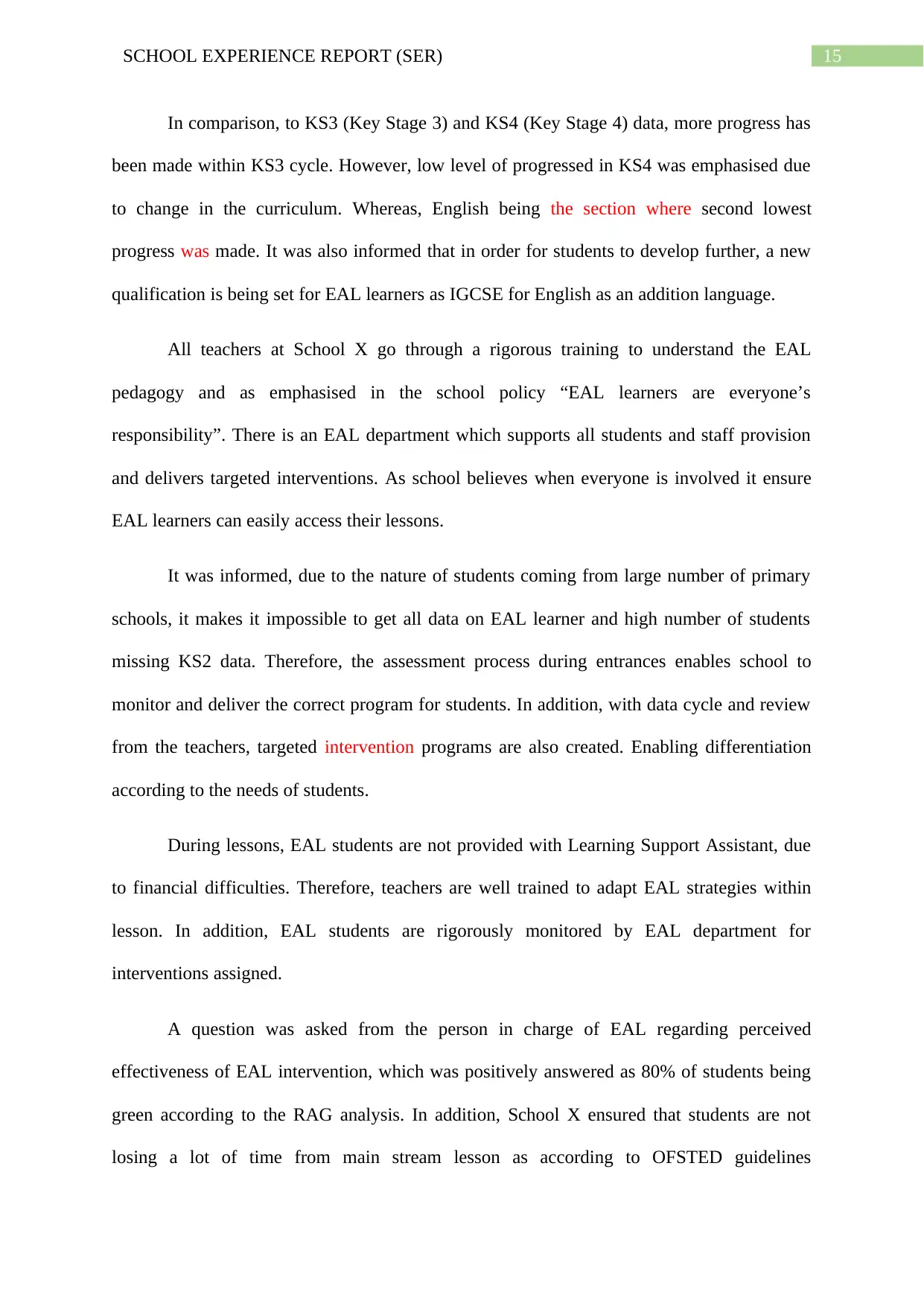
In comparison, to KS3 (Key Stage 3) and KS4 (Key Stage 4) data, more progress has
been made within KS3 cycle. However, low level of progressed in KS4 was emphasised due
to change in the curriculum. Whereas, English being the section where second lowest
progress was made. It was also informed that in order for students to develop further, a new
qualification is being set for EAL learners as IGCSE for English as an addition language.
All teachers at School X go through a rigorous training to understand the EAL
pedagogy and as emphasised in the school policy “EAL learners are everyone’s
responsibility”. There is an EAL department which supports all students and staff provision
and delivers targeted interventions. As school believes when everyone is involved it ensure
EAL learners can easily access their lessons.
It was informed, due to the nature of students coming from large number of primary
schools, it makes it impossible to get all data on EAL learner and high number of students
missing KS2 data. Therefore, the assessment process during entrances enables school to
monitor and deliver the correct program for students. In addition, with data cycle and review
from the teachers, targeted intervention programs are also created. Enabling differentiation
according to the needs of students.
During lessons, EAL students are not provided with Learning Support Assistant, due
to financial difficulties. Therefore, teachers are well trained to adapt EAL strategies within
lesson. In addition, EAL students are rigorously monitored by EAL department for
interventions assigned.
A question was asked from the person in charge of EAL regarding perceived
effectiveness of EAL intervention, which was positively answered as 80% of students being
green according to the RAG analysis. In addition, School X ensured that students are not
losing a lot of time from main stream lesson as according to OFSTED guidelines
Paraphrase This Document
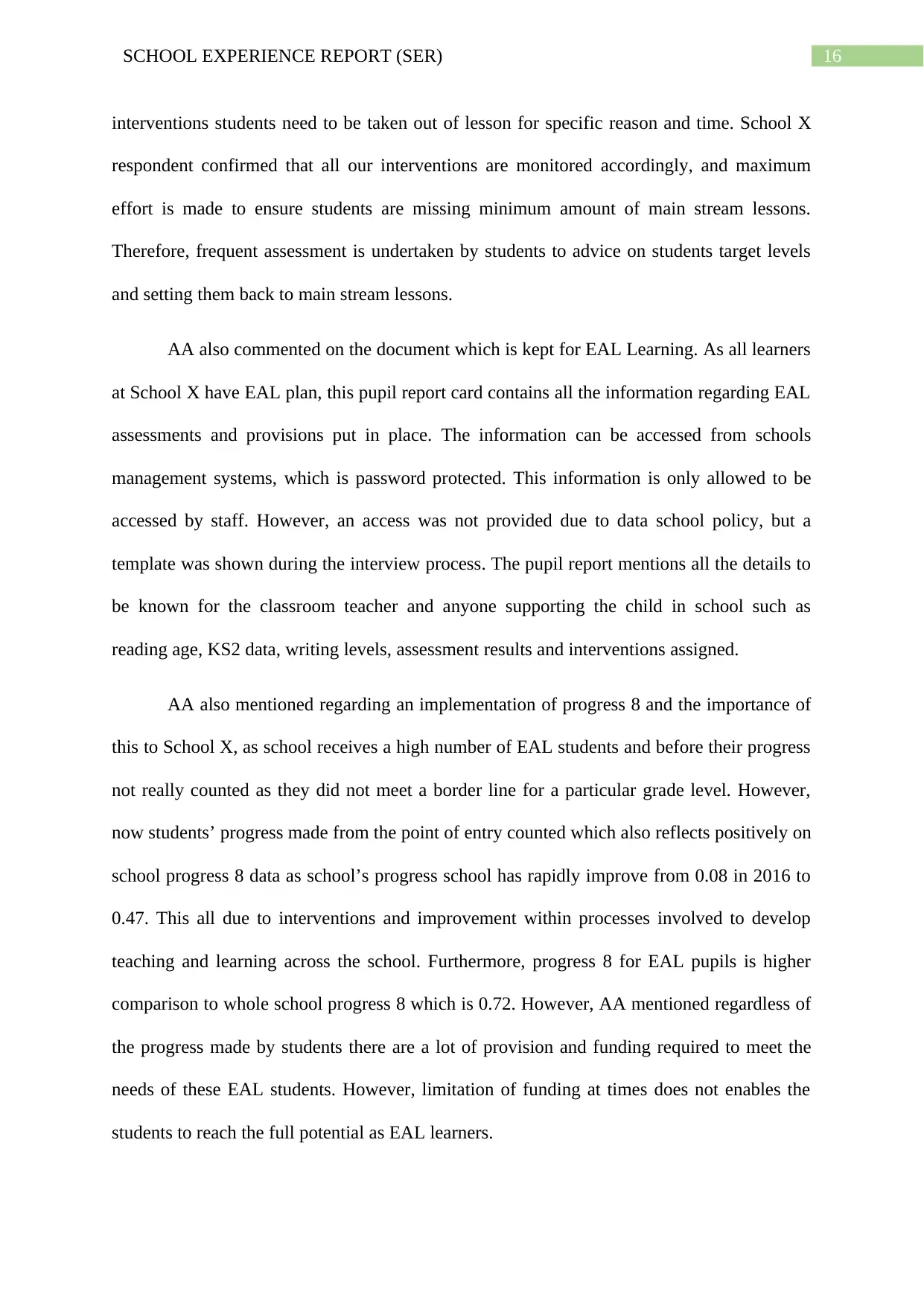
interventions students need to be taken out of lesson for specific reason and time. School X
respondent confirmed that all our interventions are monitored accordingly, and maximum
effort is made to ensure students are missing minimum amount of main stream lessons.
Therefore, frequent assessment is undertaken by students to advice on students target levels
and setting them back to main stream lessons.
AA also commented on the document which is kept for EAL Learning. As all learners
at School X have EAL plan, this pupil report card contains all the information regarding EAL
assessments and provisions put in place. The information can be accessed from schools
management systems, which is password protected. This information is only allowed to be
accessed by staff. However, an access was not provided due to data school policy, but a
template was shown during the interview process. The pupil report mentions all the details to
be known for the classroom teacher and anyone supporting the child in school such as
reading age, KS2 data, writing levels, assessment results and interventions assigned.
AA also mentioned regarding an implementation of progress 8 and the importance of
this to School X, as school receives a high number of EAL students and before their progress
not really counted as they did not meet a border line for a particular grade level. However,
now students’ progress made from the point of entry counted which also reflects positively on
school progress 8 data as school’s progress school has rapidly improve from 0.08 in 2016 to
0.47. This all due to interventions and improvement within processes involved to develop
teaching and learning across the school. Furthermore, progress 8 for EAL pupils is higher
comparison to whole school progress 8 which is 0.72. However, AA mentioned regardless of
the progress made by students there are a lot of provision and funding required to meet the
needs of these EAL students. However, limitation of funding at times does not enables the
students to reach the full potential as EAL learners.
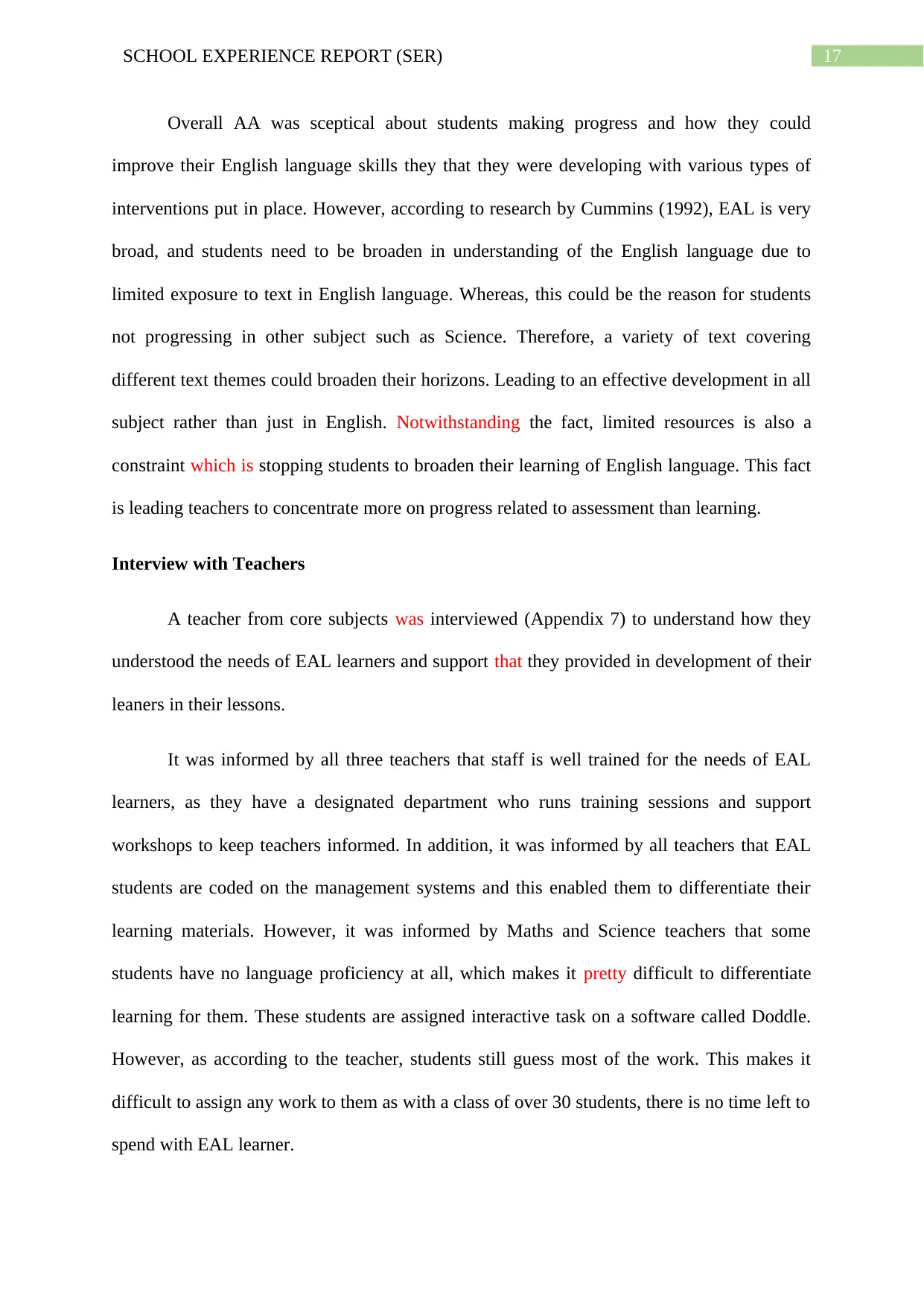
Overall AA was sceptical about students making progress and how they could
improve their English language skills they that they were developing with various types of
interventions put in place. However, according to research by Cummins (1992), EAL is very
broad, and students need to be broaden in understanding of the English language due to
limited exposure to text in English language. Whereas, this could be the reason for students
not progressing in other subject such as Science. Therefore, a variety of text covering
different text themes could broaden their horizons. Leading to an effective development in all
subject rather than just in English. Notwithstanding the fact, limited resources is also a
constraint which is stopping students to broaden their learning of English language. This fact
is leading teachers to concentrate more on progress related to assessment than learning.
Interview with Teachers
A teacher from core subjects was interviewed (Appendix 7) to understand how they
understood the needs of EAL learners and support that they provided in development of their
leaners in their lessons.
It was informed by all three teachers that staff is well trained for the needs of EAL
learners, as they have a designated department who runs training sessions and support
workshops to keep teachers informed. In addition, it was informed by all teachers that EAL
students are coded on the management systems and this enabled them to differentiate their
learning materials. However, it was informed by Maths and Science teachers that some
students have no language proficiency at all, which makes it pretty difficult to differentiate
learning for them. These students are assigned interactive task on a software called Doddle.
However, as according to the teacher, students still guess most of the work. This makes it
difficult to assign any work to them as with a class of over 30 students, there is no time left to
spend with EAL learner.
⊘ This is a preview!⊘
Do you want full access?
Subscribe today to unlock all pages.

Trusted by 1+ million students worldwide
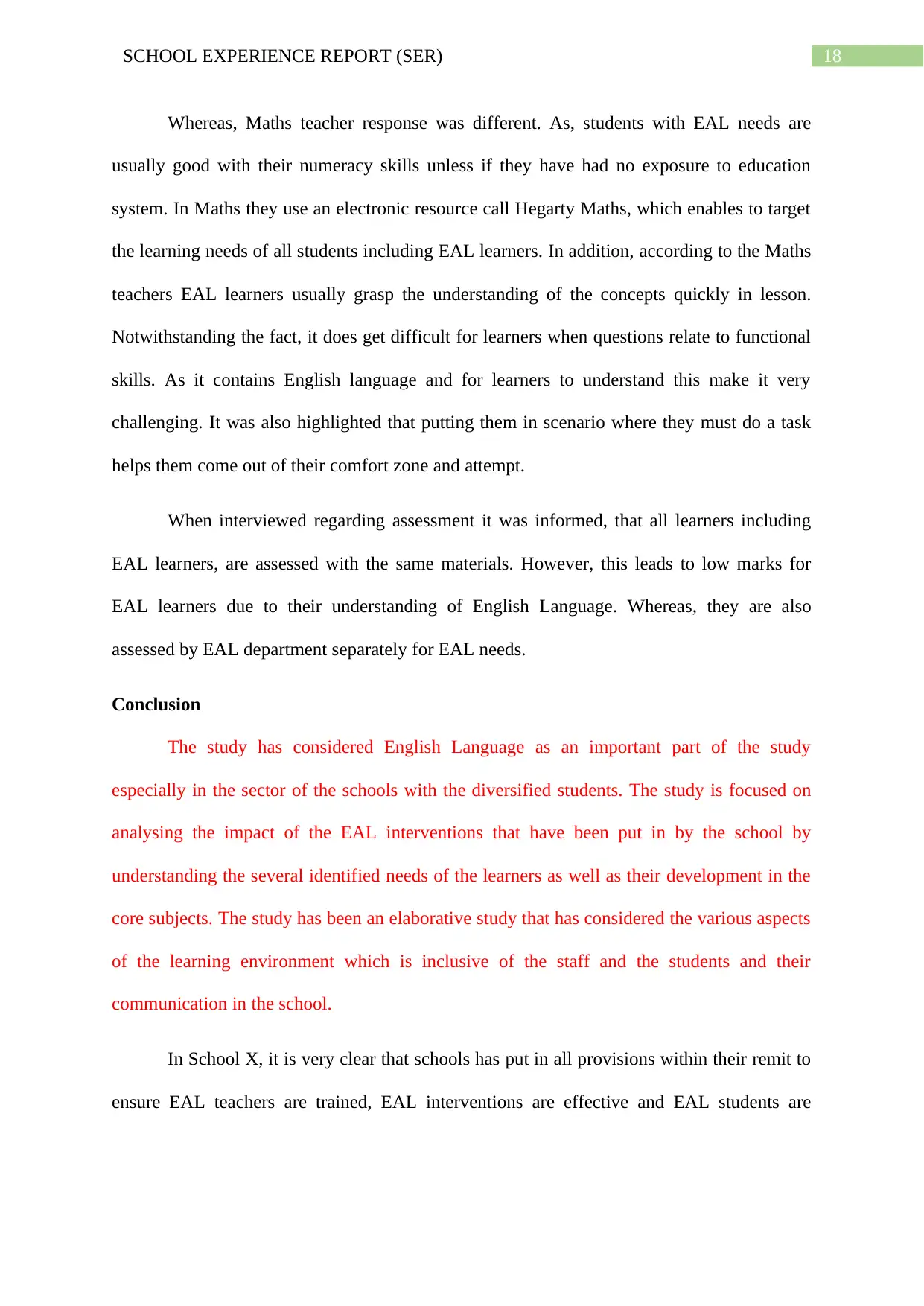
Whereas, Maths teacher response was different. As, students with EAL needs are
usually good with their numeracy skills unless if they have had no exposure to education
system. In Maths they use an electronic resource call Hegarty Maths, which enables to target
the learning needs of all students including EAL learners. In addition, according to the Maths
teachers EAL learners usually grasp the understanding of the concepts quickly in lesson.
Notwithstanding the fact, it does get difficult for learners when questions relate to functional
skills. As it contains English language and for learners to understand this make it very
challenging. It was also highlighted that putting them in scenario where they must do a task
helps them come out of their comfort zone and attempt.
When interviewed regarding assessment it was informed, that all learners including
EAL learners, are assessed with the same materials. However, this leads to low marks for
EAL learners due to their understanding of English Language. Whereas, they are also
assessed by EAL department separately for EAL needs.
Conclusion
The study has considered English Language as an important part of the study
especially in the sector of the schools with the diversified students. The study is focused on
analysing the impact of the EAL interventions that have been put in by the school by
understanding the several identified needs of the learners as well as their development in the
core subjects. The study has been an elaborative study that has considered the various aspects
of the learning environment which is inclusive of the staff and the students and their
communication in the school.
In School X, it is very clear that schools has put in all provisions within their remit to
ensure EAL teachers are trained, EAL interventions are effective and EAL students are
Paraphrase This Document
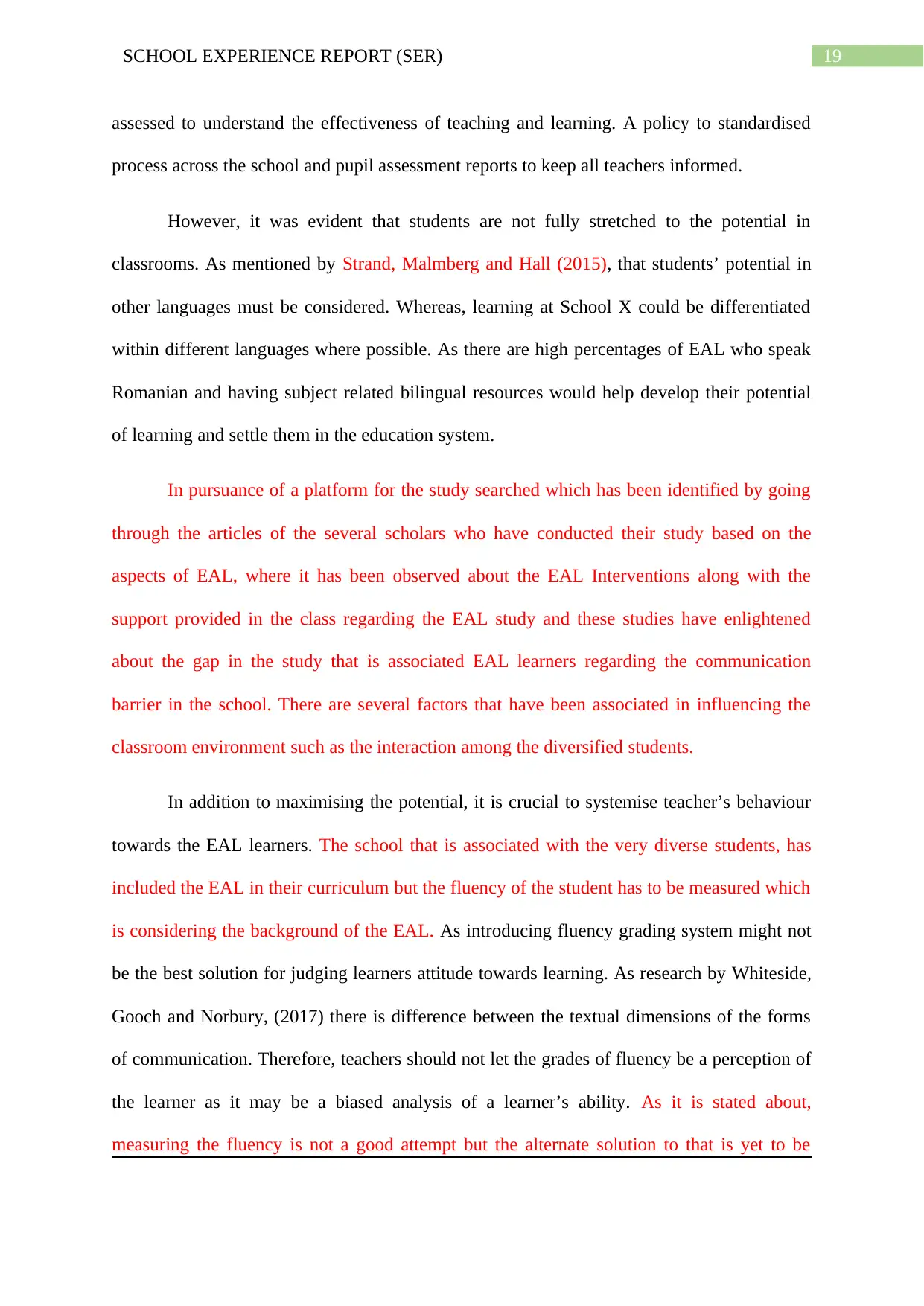
assessed to understand the effectiveness of teaching and learning. A policy to standardised
process across the school and pupil assessment reports to keep all teachers informed.
However, it was evident that students are not fully stretched to the potential in
classrooms. As mentioned by Strand, Malmberg and Hall (2015), that students’ potential in
other languages must be considered. Whereas, learning at School X could be differentiated
within different languages where possible. As there are high percentages of EAL who speak
Romanian and having subject related bilingual resources would help develop their potential
of learning and settle them in the education system.
In pursuance of a platform for the study searched which has been identified by going
through the articles of the several scholars who have conducted their study based on the
aspects of EAL, where it has been observed about the EAL Interventions along with the
support provided in the class regarding the EAL study and these studies have enlightened
about the gap in the study that is associated EAL learners regarding the communication
barrier in the school. There are several factors that have been associated in influencing the
classroom environment such as the interaction among the diversified students.
In addition to maximising the potential, it is crucial to systemise teacher’s behaviour
towards the EAL learners. The school that is associated with the very diverse students, has
included the EAL in their curriculum but the fluency of the student has to be measured which
is considering the background of the EAL. As introducing fluency grading system might not
be the best solution for judging learners attitude towards learning. As research by Whiteside,
Gooch and Norbury, (2017) there is difference between the textual dimensions of the forms
of communication. Therefore, teachers should not let the grades of fluency be a perception of
the learner as it may be a biased analysis of a learner’s ability. As it is stated about,
measuring the fluency is not a good attempt but the alternate solution to that is yet to be
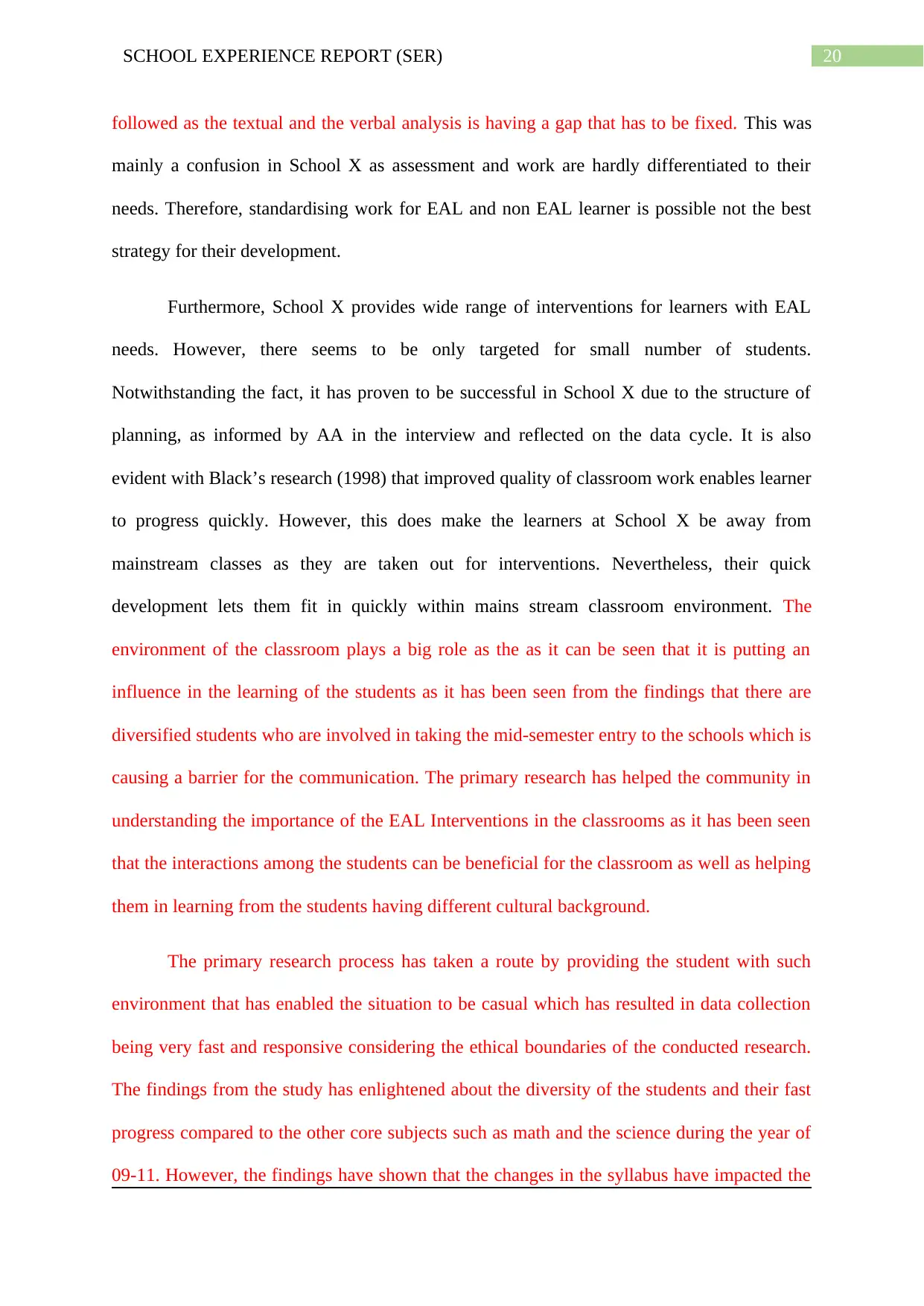
followed as the textual and the verbal analysis is having a gap that has to be fixed. This was
mainly a confusion in School X as assessment and work are hardly differentiated to their
needs. Therefore, standardising work for EAL and non EAL learner is possible not the best
strategy for their development.
Furthermore, School X provides wide range of interventions for learners with EAL
needs. However, there seems to be only targeted for small number of students.
Notwithstanding the fact, it has proven to be successful in School X due to the structure of
planning, as informed by AA in the interview and reflected on the data cycle. It is also
evident with Black’s research (1998) that improved quality of classroom work enables learner
to progress quickly. However, this does make the learners at School X be away from
mainstream classes as they are taken out for interventions. Nevertheless, their quick
development lets them fit in quickly within mains stream classroom environment. The
environment of the classroom plays a big role as the as it can be seen that it is putting an
influence in the learning of the students as it has been seen from the findings that there are
diversified students who are involved in taking the mid-semester entry to the schools which is
causing a barrier for the communication. The primary research has helped the community in
understanding the importance of the EAL Interventions in the classrooms as it has been seen
that the interactions among the students can be beneficial for the classroom as well as helping
them in learning from the students having different cultural background.
The primary research process has taken a route by providing the student with such
environment that has enabled the situation to be casual which has resulted in data collection
being very fast and responsive considering the ethical boundaries of the conducted research.
The findings from the study has enlightened about the diversity of the students and their fast
progress compared to the other core subjects such as math and the science during the year of
09-11. However, the findings have shown that the changes in the syllabus have impacted the
⊘ This is a preview!⊘
Do you want full access?
Subscribe today to unlock all pages.

Trusted by 1+ million students worldwide
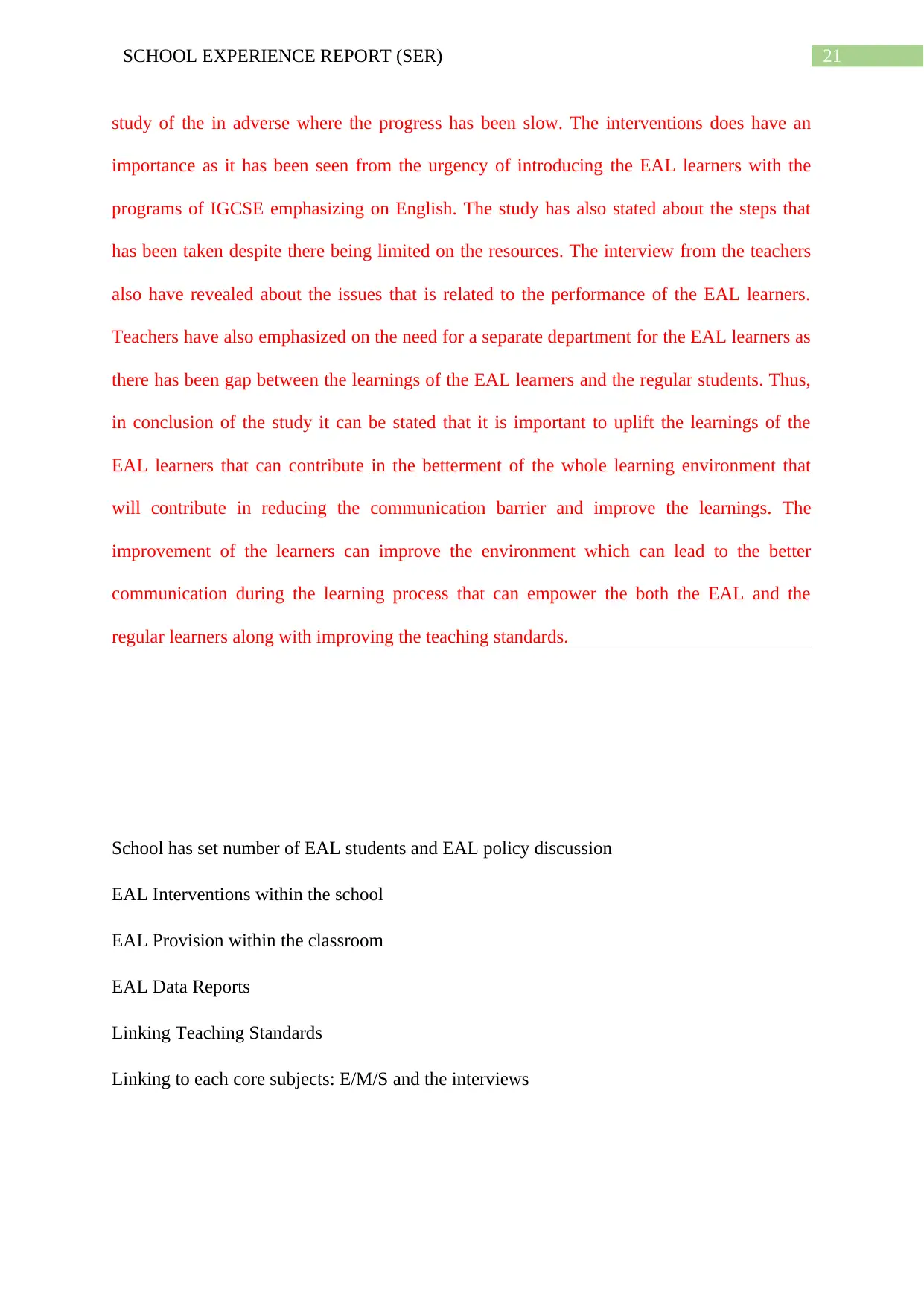
study of the in adverse where the progress has been slow. The interventions does have an
importance as it has been seen from the urgency of introducing the EAL learners with the
programs of IGCSE emphasizing on English. The study has also stated about the steps that
has been taken despite there being limited on the resources. The interview from the teachers
also have revealed about the issues that is related to the performance of the EAL learners.
Teachers have also emphasized on the need for a separate department for the EAL learners as
there has been gap between the learnings of the EAL learners and the regular students. Thus,
in conclusion of the study it can be stated that it is important to uplift the learnings of the
EAL learners that can contribute in the betterment of the whole learning environment that
will contribute in reducing the communication barrier and improve the learnings. The
improvement of the learners can improve the environment which can lead to the better
communication during the learning process that can empower the both the EAL and the
regular learners along with improving the teaching standards.
School has set number of EAL students and EAL policy discussion
EAL Interventions within the school
EAL Provision within the classroom
EAL Data Reports
Linking Teaching Standards
Linking to each core subjects: E/M/S and the interviews
Paraphrase This Document
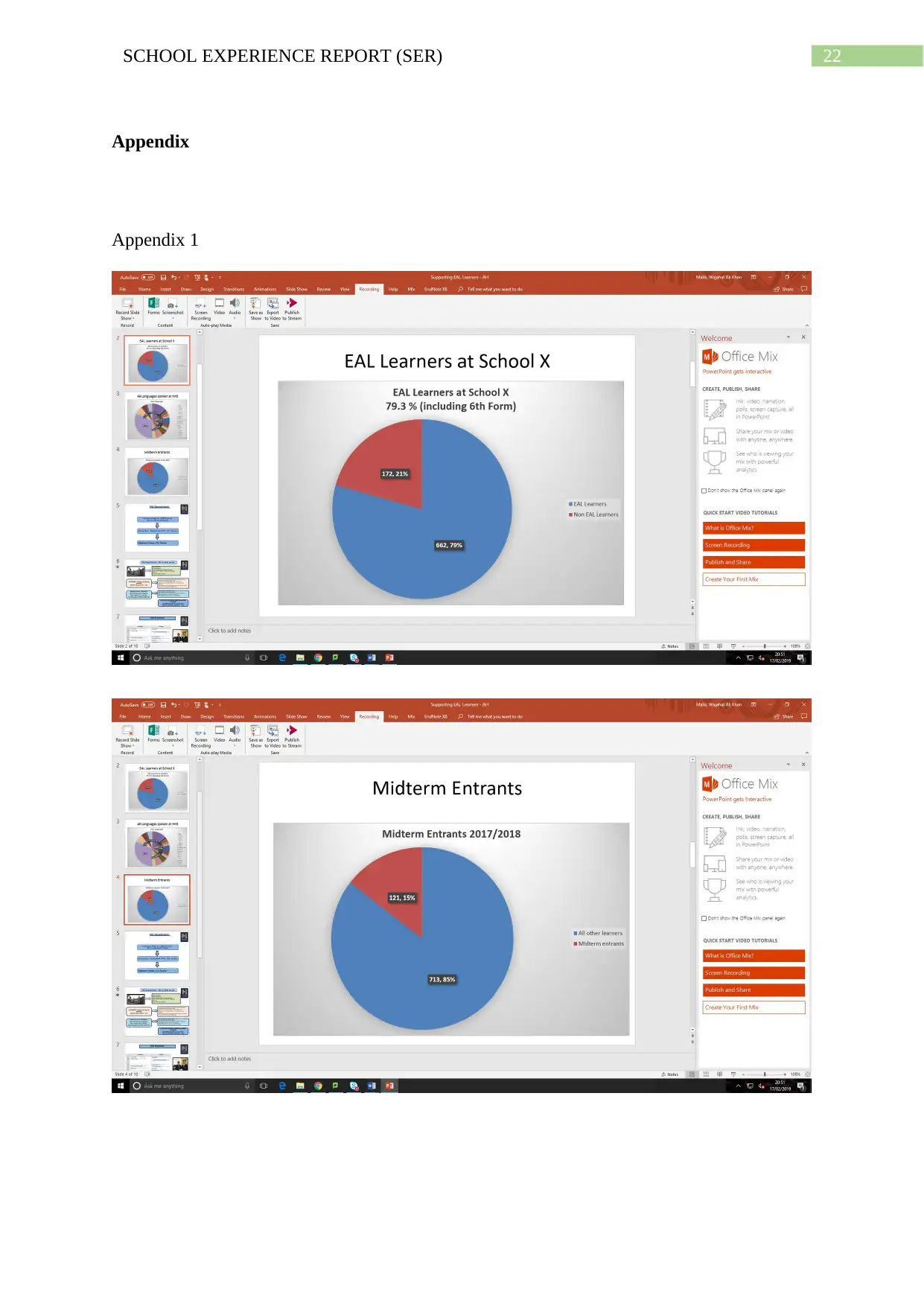
Appendix
Appendix 1
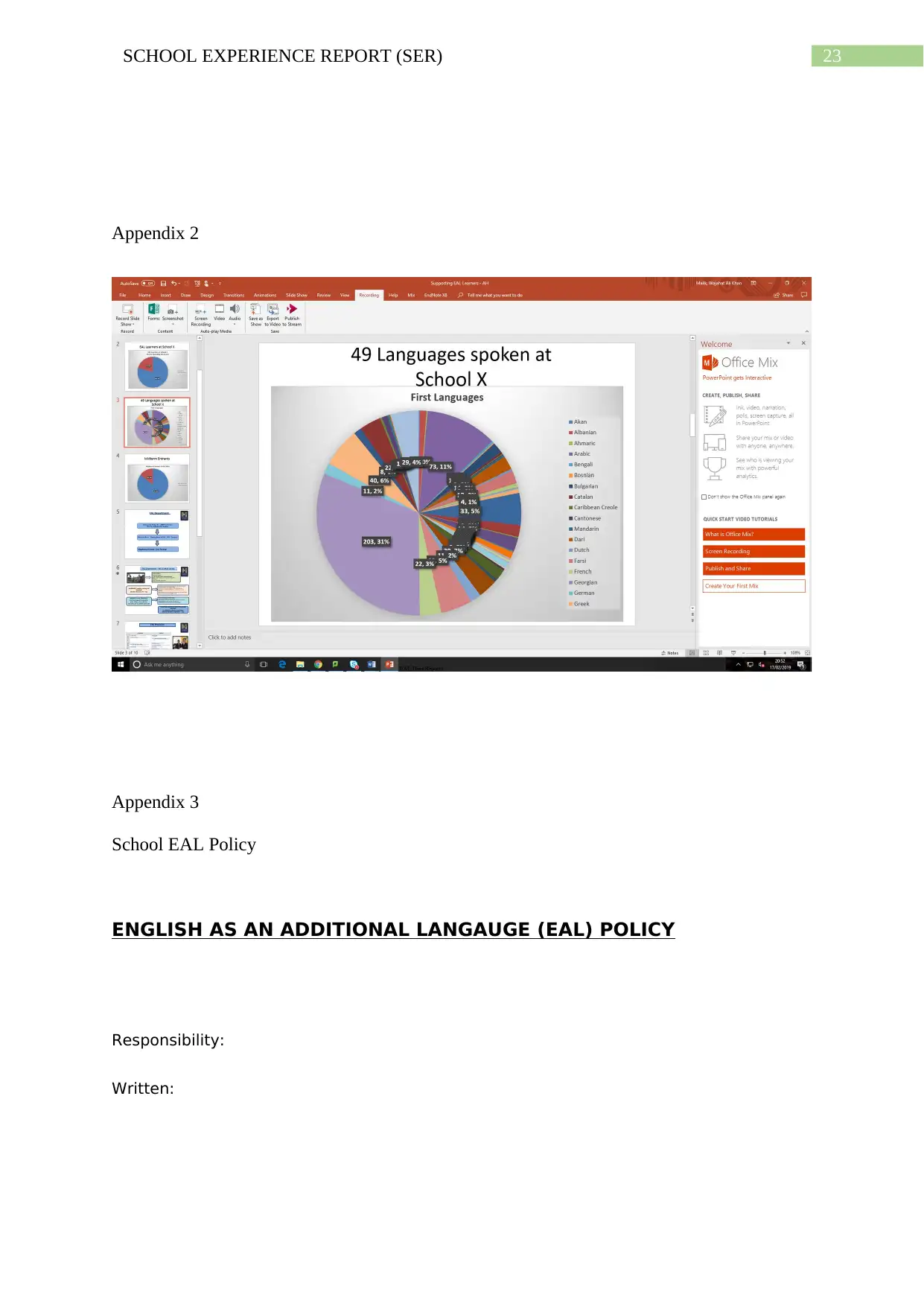
Appendix 2
Appendix 3
School EAL Policy
ENGLISH AS AN ADDITIONAL LANGAUGE (EAL) POLICY
Responsibility:
Written:
⊘ This is a preview!⊘
Do you want full access?
Subscribe today to unlock all pages.

Trusted by 1+ million students worldwide
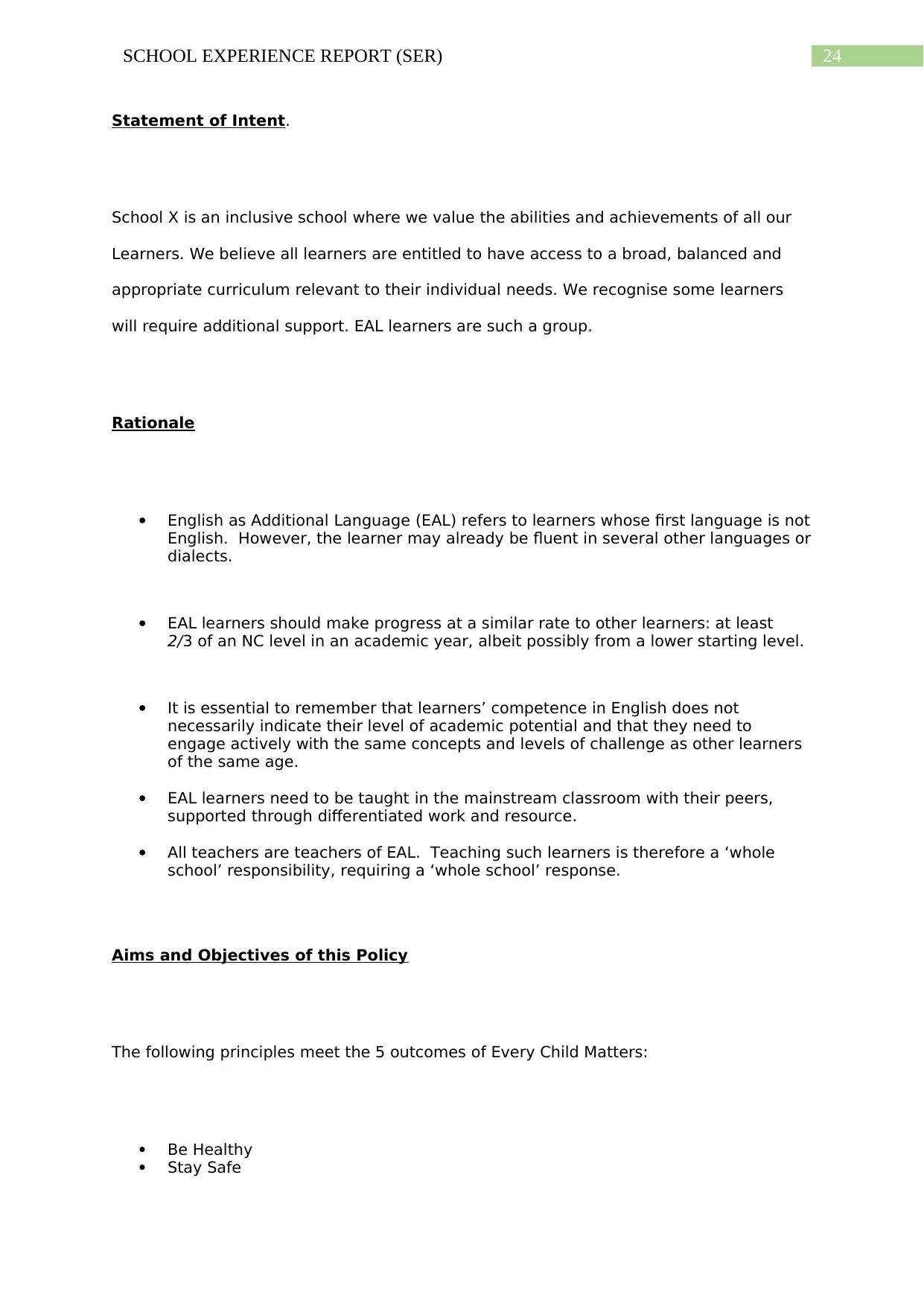
Statement of Intent.
School X is an inclusive school where we value the abilities and achievements of all our
Learners. We believe all learners are entitled to have access to a broad, balanced and
appropriate curriculum relevant to their individual needs. We recognise some learners
will require additional support. EAL learners are such a group.
Rationale
English as Additional Language (EAL) refers to learners whose first language is not
English. However, the learner may already be fluent in several other languages or
dialects.
EAL learners should make progress at a similar rate to other learners: at least
2/3 of an NC level in an academic year, albeit possibly from a lower starting level.
It is essential to remember that learners’ competence in English does not
necessarily indicate their level of academic potential and that they need to
engage actively with the same concepts and levels of challenge as other learners
of the same age.
EAL learners need to be taught in the mainstream classroom with their peers,
supported through differentiated work and resource.
All teachers are teachers of EAL. Teaching such learners is therefore a ‘whole
school’ responsibility, requiring a ‘whole school’ response.
Aims and Objectives of this Policy
The following principles meet the 5 outcomes of Every Child Matters:
Be Healthy
Stay Safe
Paraphrase This Document

Enjoy and Achieve
Make a positive contribution
Achieve economic wellbeing
AIMS
To be proactive in removing barriers that stand in the way of learning and success
All teachers of EAL ensure equal access to the curriculum (and other educational
opportunities) and the achievement of educational potential.
To provide a safe, welcoming, nurturing environment where they are accepted,
valued and encouraged to participate.
To reach high levels of achievement for all
To be an inclusive School
To ensure the identification of all Learners requiring EAL provision as early as
possible in their school career.
To meet individual’s need through a wide range of provision.
To attain high levels of satisfaction and participation of learners, parents and
carers.
To share a common vision and understanding with all stakeholders
To give transparent resourcing to EAL
To work towards inclusion in partnership with other agencies and schools
To achieve a level of staff expertise to meet learners’ needs.
Relationship to other Policies
This policy should be read in conjunction with the policies on the School Curriculum,
Teaching and Learning, Assessment, Recording and reporting, the Equal Opportunities
Policy and the Anti-Bullying Policy, Exams Policy, Behaviour for Learning, Mid-term Entry
Policy.
Responsibilities
The Governing Body will support policy implementation and ensure, in particular that
admission arrangements are administered in accordance with the guidance set out in the
Admissions Arrangements published by the Local Authority.
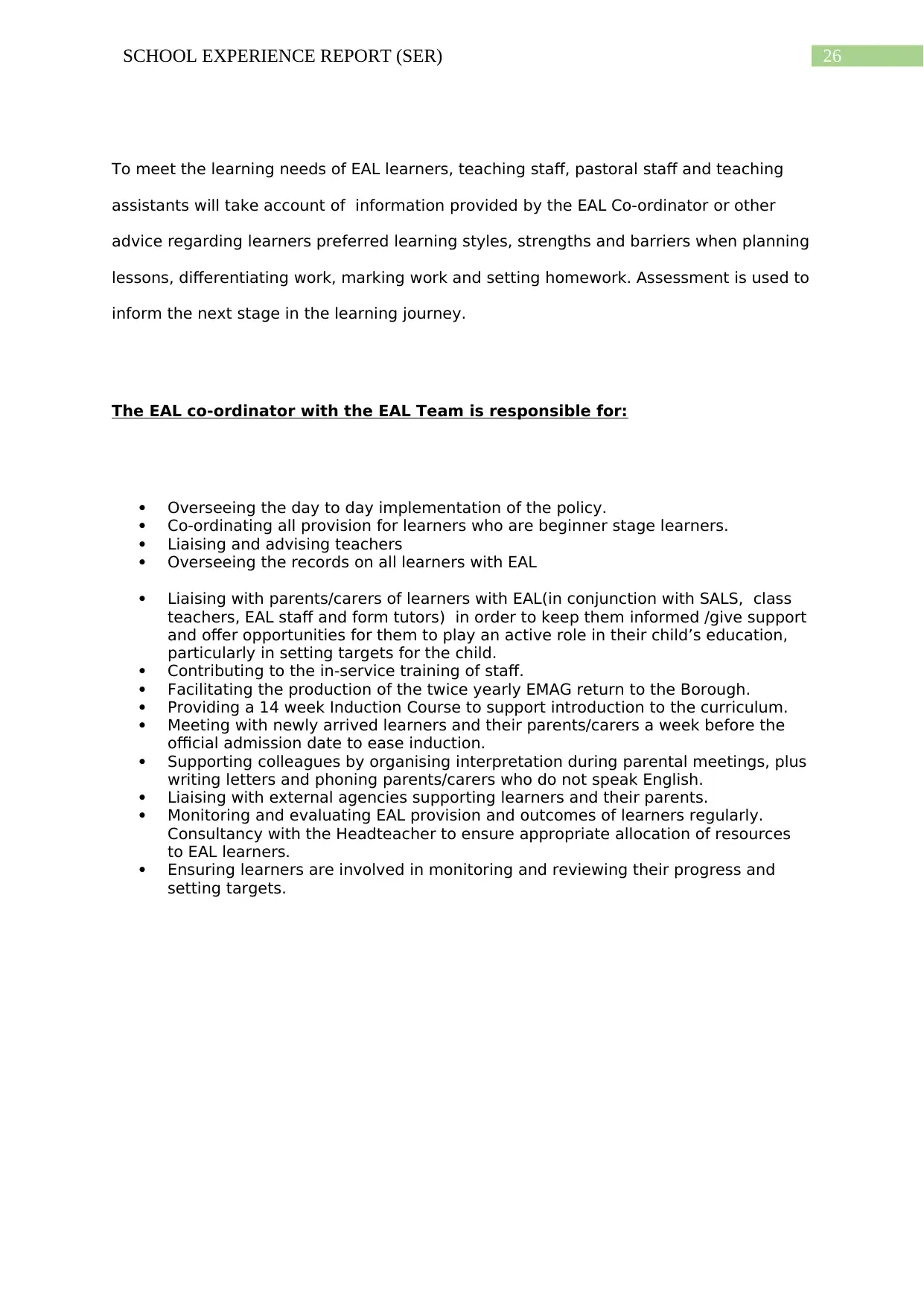
To meet the learning needs of EAL learners, teaching staff, pastoral staff and teaching
assistants will take account of information provided by the EAL Co-ordinator or other
advice regarding learners preferred learning styles, strengths and barriers when planning
lessons, differentiating work, marking work and setting homework. Assessment is used to
inform the next stage in the learning journey.
The EAL co-ordinator with the EAL Team is responsible for:
Overseeing the day to day implementation of the policy.
Co-ordinating all provision for learners who are beginner stage learners.
Liaising and advising teachers
Overseeing the records on all learners with EAL
Liaising with parents/carers of learners with EAL(in conjunction with SALS, class
teachers, EAL staff and form tutors) in order to keep them informed /give support
and offer opportunities for them to play an active role in their child’s education,
particularly in setting targets for the child.
Contributing to the in-service training of staff.
Facilitating the production of the twice yearly EMAG return to the Borough.
Providing a 14 week Induction Course to support introduction to the curriculum.
Meeting with newly arrived learners and their parents/carers a week before the
official admission date to ease induction.
Supporting colleagues by organising interpretation during parental meetings, plus
writing letters and phoning parents/carers who do not speak English.
Liaising with external agencies supporting learners and their parents.
Monitoring and evaluating EAL provision and outcomes of learners regularly.
Consultancy with the Headteacher to ensure appropriate allocation of resources
to EAL learners.
Ensuring learners are involved in monitoring and reviewing their progress and
setting targets.
⊘ This is a preview!⊘
Do you want full access?
Subscribe today to unlock all pages.

Trusted by 1+ million students worldwide
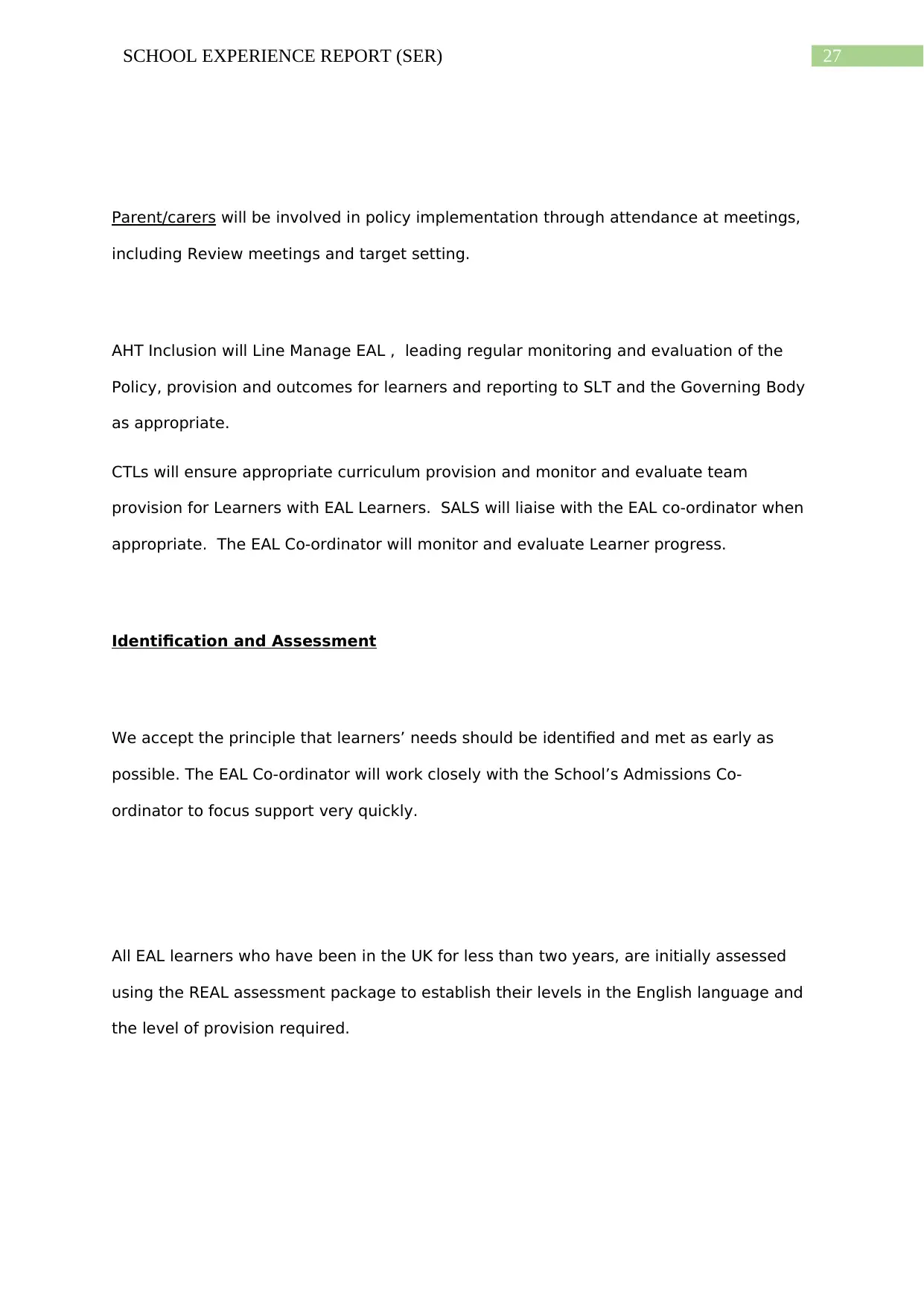
Parent/carers will be involved in policy implementation through attendance at meetings,
including Review meetings and target setting.
AHT Inclusion will Line Manage EAL , leading regular monitoring and evaluation of the
Policy, provision and outcomes for learners and reporting to SLT and the Governing Body
as appropriate.
CTLs will ensure appropriate curriculum provision and monitor and evaluate team
provision for Learners with EAL Learners. SALS will liaise with the EAL co-ordinator when
appropriate. The EAL Co-ordinator will monitor and evaluate Learner progress.
Identification and Assessment
We accept the principle that learners’ needs should be identified and met as early as
possible. The EAL Co-ordinator will work closely with the School’s Admissions Co-
ordinator to focus support very quickly.
All EAL learners who have been in the UK for less than two years, are initially assessed
using the REAL assessment package to establish their levels in the English language and
the level of provision required.
Paraphrase This Document
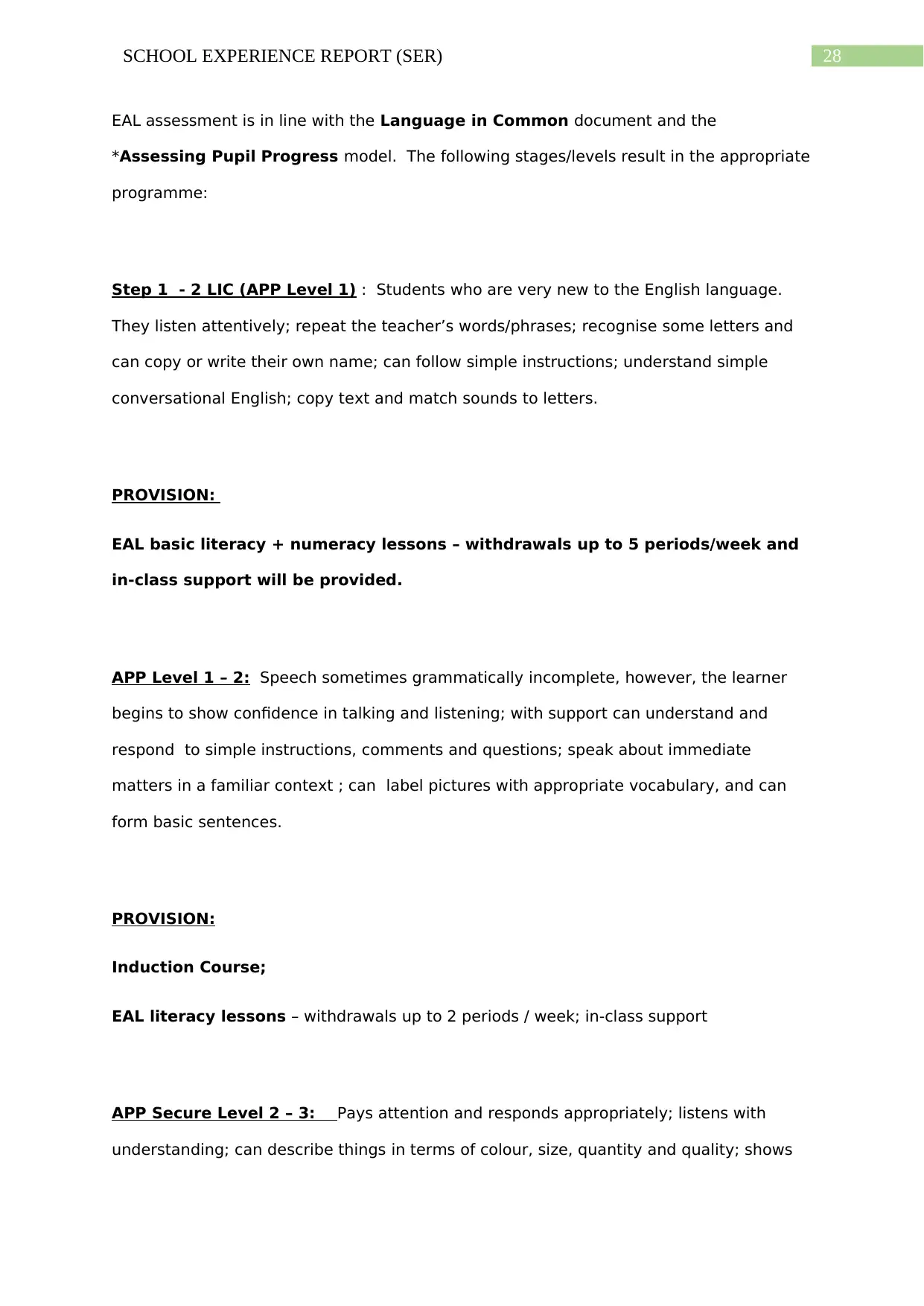
EAL assessment is in line with the Language in Common document and the
*Assessing Pupil Progress model. The following stages/levels result in the appropriate
programme:
Step 1 - 2 LIC (APP Level 1) : Students who are very new to the English language.
They listen attentively; repeat the teacher’s words/phrases; recognise some letters and
can copy or write their own name; can follow simple instructions; understand simple
conversational English; copy text and match sounds to letters.
PROVISION:
EAL basic literacy + numeracy lessons – withdrawals up to 5 periods/week and
in-class support will be provided.
APP Level 1 – 2: Speech sometimes grammatically incomplete, however, the learner
begins to show confidence in talking and listening; with support can understand and
respond to simple instructions, comments and questions; speak about immediate
matters in a familiar context ; can label pictures with appropriate vocabulary, and can
form basic sentences.
PROVISION:
Induction Course;
EAL literacy lessons – withdrawals up to 2 periods / week; in-class support
APP Secure Level 2 – 3: Pays attention and responds appropriately; listens with
understanding; can describe things in terms of colour, size, quantity and quality; shows

understanding of appropriate texts; reading a range of texts accurately and fluently; uses
capital letters and full stops. The basic grammatical structure of sentences is usually
accurate.
PROVISION:
Induction Course – EAL Writing Booster lessons – withdrawals 1 period / week
APP Level 4: able to return to mainstream lessons full time, with additional support;
talks and listens confidently; responds to a range of texts; shows understanding of
significant themes, events and ideas; begins to use grammatically complex sentences,
inference and deduction.
PROVISION:
In-class support - Assessing Pupils Progress (APP) in line with mainstream
assessment where applicable.
The number of EAL lessons may vary according to learners’ needs.
The overall assessment of EAL learners is based on writing skills, which determine the
EMA
⊘ This is a preview!⊘
Do you want full access?
Subscribe today to unlock all pages.

Trusted by 1+ million students worldwide
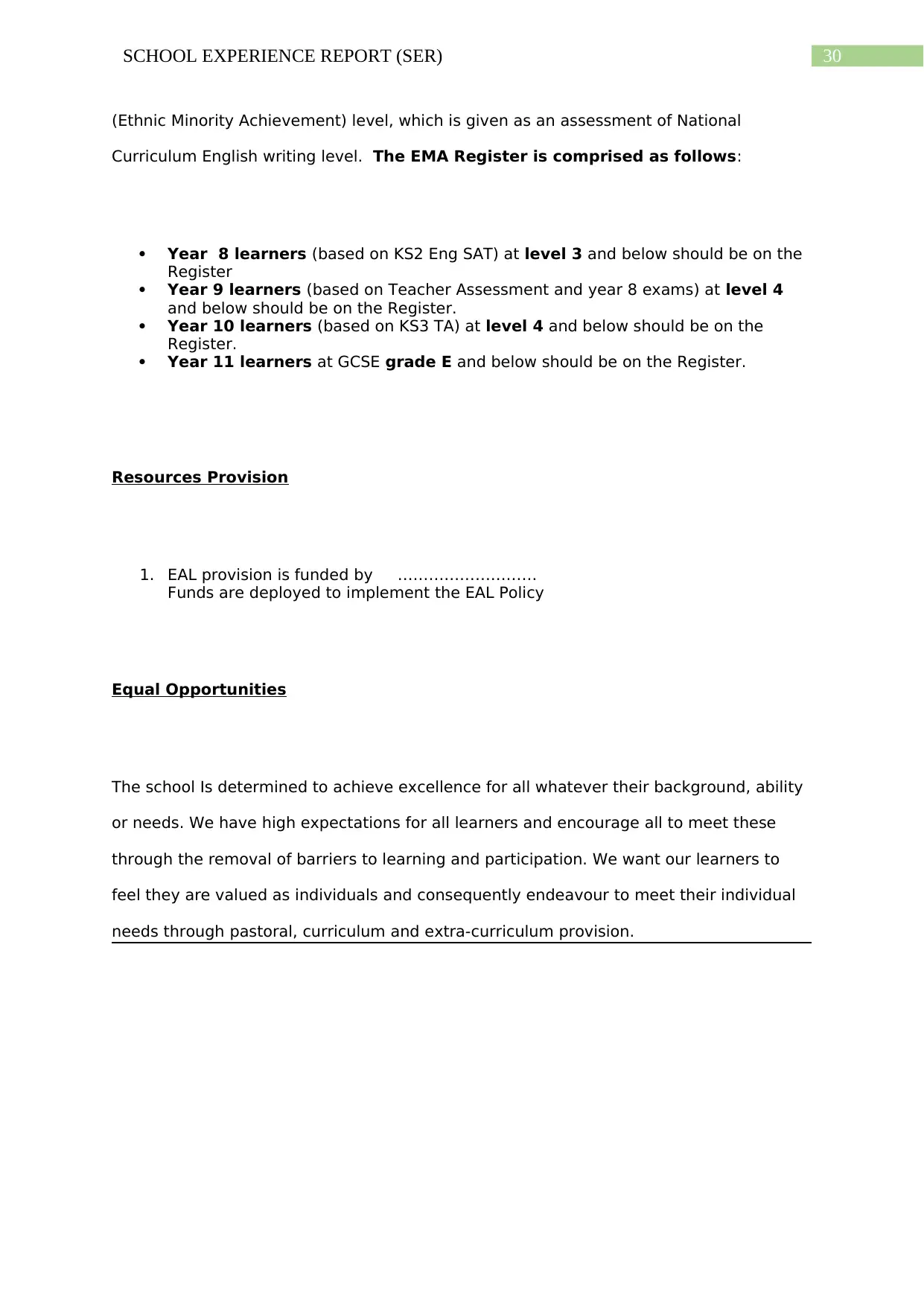
(Ethnic Minority Achievement) level, which is given as an assessment of National
Curriculum English writing level. The EMA Register is comprised as follows:
Year 8 learners (based on KS2 Eng SAT) at level 3 and below should be on the
Register
Year 9 learners (based on Teacher Assessment and year 8 exams) at level 4
and below should be on the Register.
Year 10 learners (based on KS3 TA) at level 4 and below should be on the
Register.
Year 11 learners at GCSE grade E and below should be on the Register.
Resources Provision
1. EAL provision is funded by ………………………
Funds are deployed to implement the EAL Policy
Equal Opportunities
The school Is determined to achieve excellence for all whatever their background, ability
or needs. We have high expectations for all learners and encourage all to meet these
through the removal of barriers to learning and participation. We want our learners to
feel they are valued as individuals and consequently endeavour to meet their individual
needs through pastoral, curriculum and extra-curriculum provision.
Paraphrase This Document
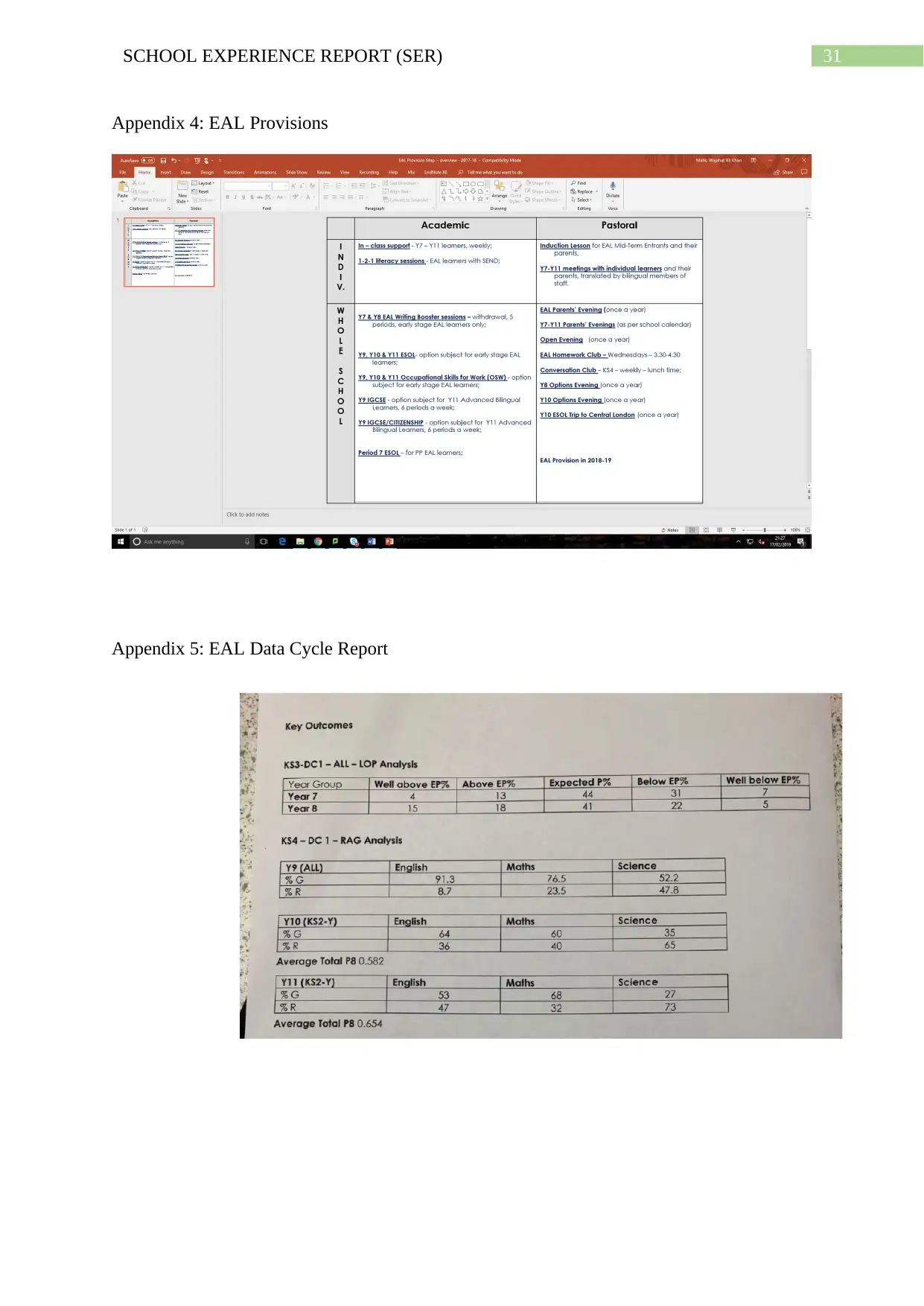
Appendix 4: EAL Provisions
Appendix 5: EAL Data Cycle Report

⊘ This is a preview!⊘
Do you want full access?
Subscribe today to unlock all pages.

Trusted by 1+ million students worldwide
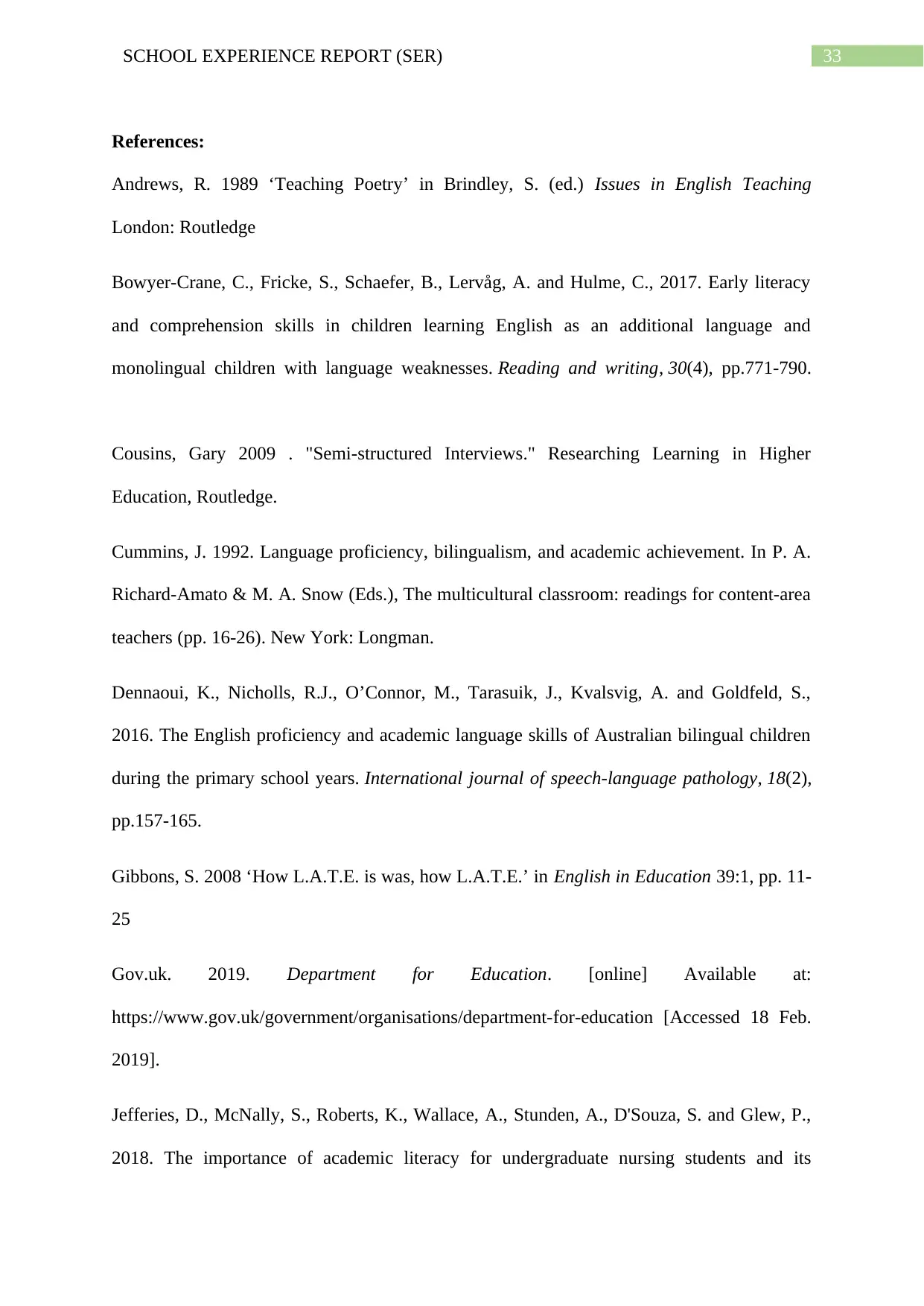
References:
Andrews, R. 1989 ‘Teaching Poetry’ in Brindley, S. (ed.) Issues in English Teaching
London: Routledge
Bowyer-Crane, C., Fricke, S., Schaefer, B., Lervåg, A. and Hulme, C., 2017. Early literacy
and comprehension skills in children learning English as an additional language and
monolingual children with language weaknesses. Reading and writing, 30(4), pp.771-790.
Cousins, Gary 2009 . "Semi-structured Interviews." Researching Learning in Higher
Education, Routledge.
Cummins, J. 1992. Language proficiency, bilingualism, and academic achievement. In P. A.
Richard-Amato & M. A. Snow (Eds.), The multicultural classroom: readings for content-area
teachers (pp. 16-26). New York: Longman.
Dennaoui, K., Nicholls, R.J., O’Connor, M., Tarasuik, J., Kvalsvig, A. and Goldfeld, S.,
2016. The English proficiency and academic language skills of Australian bilingual children
during the primary school years. International journal of speech-language pathology, 18(2),
pp.157-165.
Gibbons, S. 2008 ‘How L.A.T.E. is was, how L.A.T.E.’ in English in Education 39:1, pp. 11-
25
Gov.uk. 2019. Department for Education. [online] Available at:
https://www.gov.uk/government/organisations/department-for-education [Accessed 18 Feb.
2019].
Jefferies, D., McNally, S., Roberts, K., Wallace, A., Stunden, A., D'Souza, S. and Glew, P.,
2018. The importance of academic literacy for undergraduate nursing students and its
Paraphrase This Document
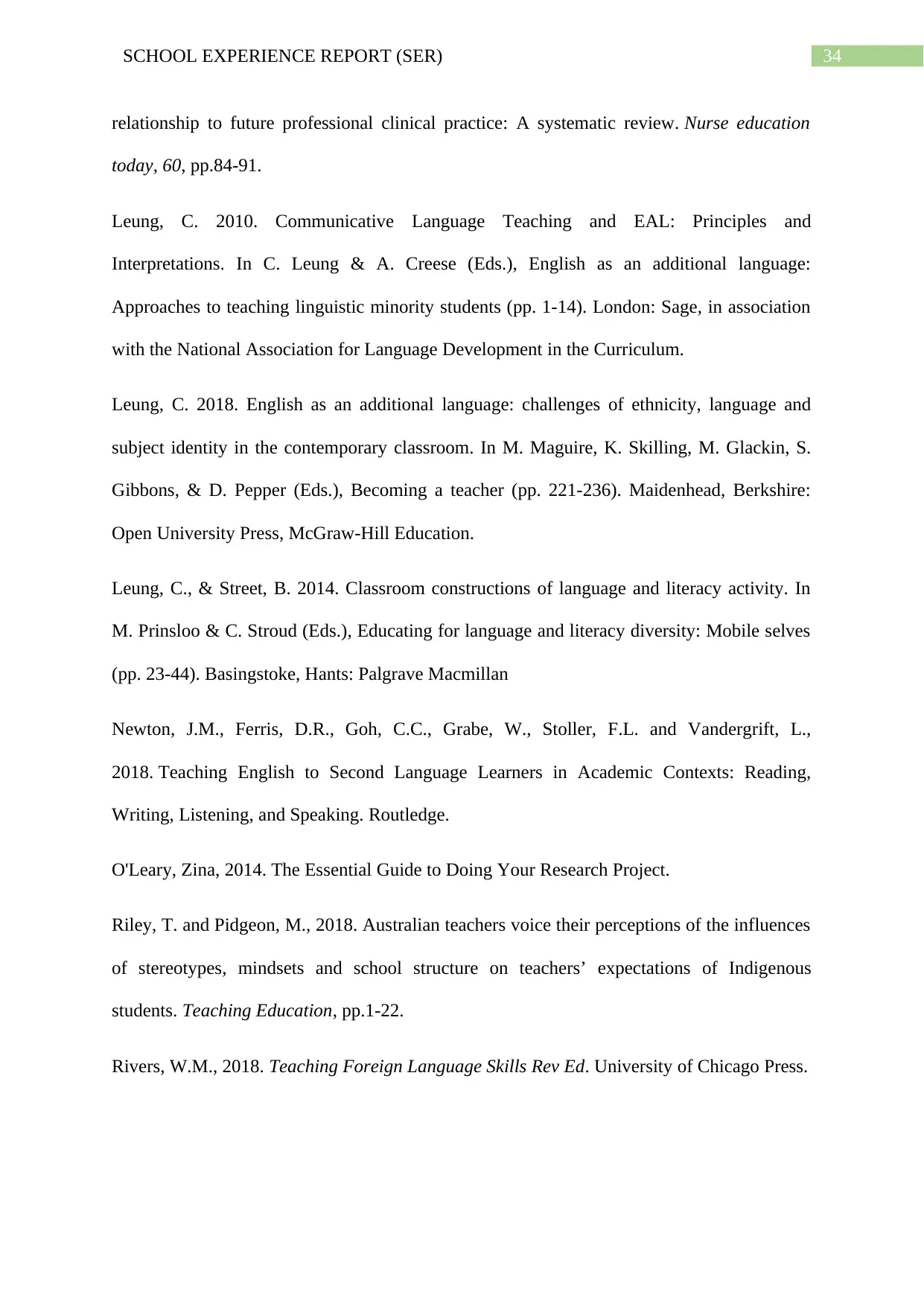
relationship to future professional clinical practice: A systematic review. Nurse education
today, 60, pp.84-91.
Leung, C. 2010. Communicative Language Teaching and EAL: Principles and
Interpretations. In C. Leung & A. Creese (Eds.), English as an additional language:
Approaches to teaching linguistic minority students (pp. 1-14). London: Sage, in association
with the National Association for Language Development in the Curriculum.
Leung, C. 2018. English as an additional language: challenges of ethnicity, language and
subject identity in the contemporary classroom. In M. Maguire, K. Skilling, M. Glackin, S.
Gibbons, & D. Pepper (Eds.), Becoming a teacher (pp. 221-236). Maidenhead, Berkshire:
Open University Press, McGraw-Hill Education.
Leung, C., & Street, B. 2014. Classroom constructions of language and literacy activity. In
M. Prinsloo & C. Stroud (Eds.), Educating for language and literacy diversity: Mobile selves
(pp. 23-44). Basingstoke, Hants: Palgrave Macmillan
Newton, J.M., Ferris, D.R., Goh, C.C., Grabe, W., Stoller, F.L. and Vandergrift, L.,
2018. Teaching English to Second Language Learners in Academic Contexts: Reading,
Writing, Listening, and Speaking. Routledge.
O'Leary, Zina, 2014. The Essential Guide to Doing Your Research Project.
Riley, T. and Pidgeon, M., 2018. Australian teachers voice their perceptions of the influences
of stereotypes, mindsets and school structure on teachers’ expectations of Indigenous
students. Teaching Education, pp.1-22.
Rivers, W.M., 2018. Teaching Foreign Language Skills Rev Ed. University of Chicago Press.

Siegel, L. and Lipka, O., 2017. The influence of first language on learning English as an
additional language. Developmental Perspectives in Written Language and Literacy: In
honor of Ludo Verhoeven, p.183.
Strand, S., Malmberg, L. and Hall, J., 2015. English as an Additional Language (EAL) and
educational achievement in England: An analysis of the National Pupil Database.
Uccelli, P., Demir‐Lira, Ö.E., Rowe, M.L., Levine, S. and Goldin‐Meadow, S., 2018.
Children's Early Decontextualized Talk Predicts Academic Language Proficiency in
Midadolescence. Child development.
Whiteside, K.E., Gooch, D. and Norbury, C.F., 2017. English language proficiency and early
school attainment among children learning English as an additional language. Child
development, 88(3), pp.812-827.
⊘ This is a preview!⊘
Do you want full access?
Subscribe today to unlock all pages.

Trusted by 1+ million students worldwide
Related Documents
Your All-in-One AI-Powered Toolkit for Academic Success.
+13062052269
info@desklib.com
Available 24*7 on WhatsApp / Email
![[object Object]](/_next/static/media/star-bottom.7253800d.svg)
© 2024 | Zucol Services PVT LTD | All rights reserved.





